1974: Act 4: the battle of the sexes (women's lib)

 FF150
151
152
153
154
155
156
157
158
159
160
161
162
163
164
165
166
167
168
169
170
annual 11
171
172
173
174
175
FF150
151
152
153
154
155
156
157
158
159
160
161
162
163
164
165
166
167
168
169
170
annual 11
171
172
173
174
175

Summary
With America's male rulers failing so badly, the mid 1970s saw women's
liberation reach the mainstream. The FF reflects this: story after story
about the role of men and women and families.
- FF150-154: Reed and Sue are back together. But the sexes are still at war.
- FF155-157: The the midpoint story of the whole 28 year epic, with all
major themes and motifs.
-
FF158-159: Sue effectively takes over.
- FF160-163: Reed fails, and causes a war of the worlds.
- FF164-165: Ben and Johnny have had enough of Reed.
- FF166-171: Ben rejects his humanity.
- Annual 11, FF172: America's bicentennial
- FF172-175: Ben failed his test. Sue succeeds and saves the world again.
150
Issue 150: what Franklin can do
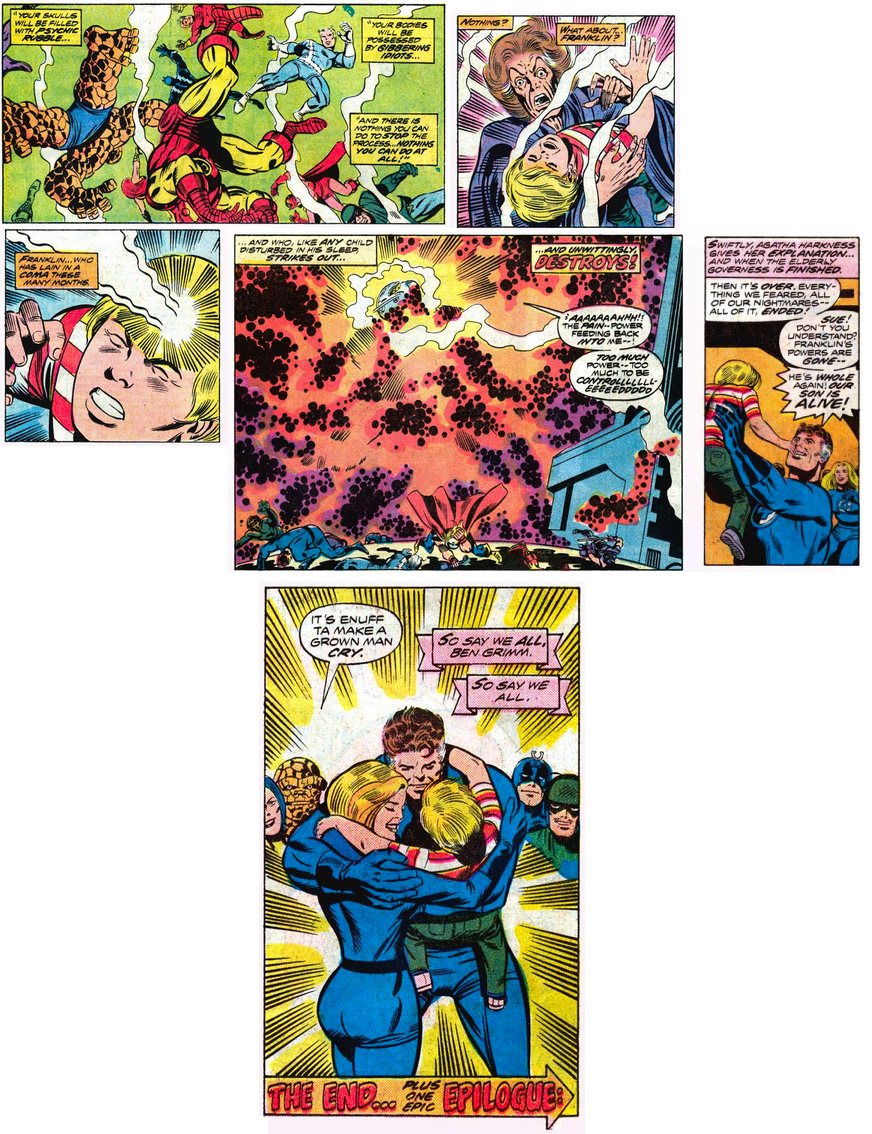
This is the clearest example yet of what Franklin can do: the
combined might of the Avengers (including Thor) and the Inhumans
(including Black Bolt - see FF annual 12 for the extent of his
power) and the Fantastic Four, including the witch Agatha
Harkness, cannot stop this threat,. but Franklin can stop it in
his sleep. But still Reed will not pay him any attention. He gives
him the occasional hug (Reed is not a monster) and then packs him
away to Agatha, the one who gave Franklin up to Annihilus, in the
house that last time they passed it was just a smoking crater. Sue
is giving Reed another chance, but Reed has not changes.
As for Crystal, did she really want to get married? She was
having second thoughts but she had promised, and she always does
her duty. For the tragic details see
Crystal's own page.
|
GS "Giant Size Fantastic Four": just a comic?
At the same time as FF151-154, Marvel published "Giant Sized
Fantastic Four" issues 1 to 4. They were designed as stand
alone stories, so
are not closely tied to the main continuity. Or are they?
When I frst made this web site I ignored these issues for that reason,
but one day I should examine them in depth. Here is just an overview.
Points to note:
-
Hulk v Thing:
Issue 1 nicely illustrates Ben's
strength in comparison with the Hulk. Yes, Ben's
body can defeat the Hulk's body: this time it's the
Hulk body making excuses. The art is great.
-
American history:
Issue 2 is a natural sibling to FF Annual 11: Ben's
comment in FF Annual 11 links the two, and between
them they serve as a guide through America's past. The
final battle of issue 2 can be seen as a comment on Marvel Time: if a
character cannot change then his existence is
meaningless and he eventually longs for death
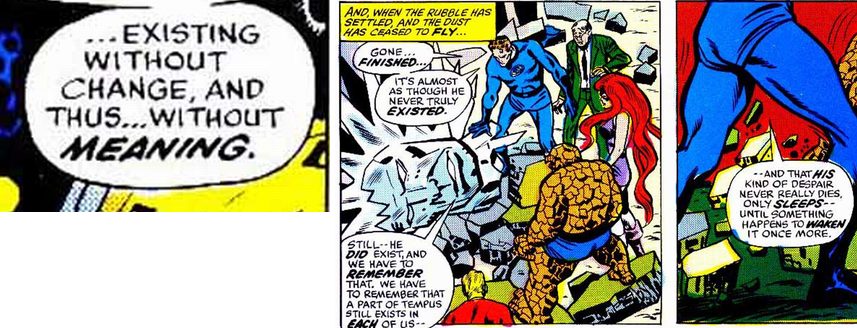
This might be a good point to show a picture from the 1976 Marvel calender.
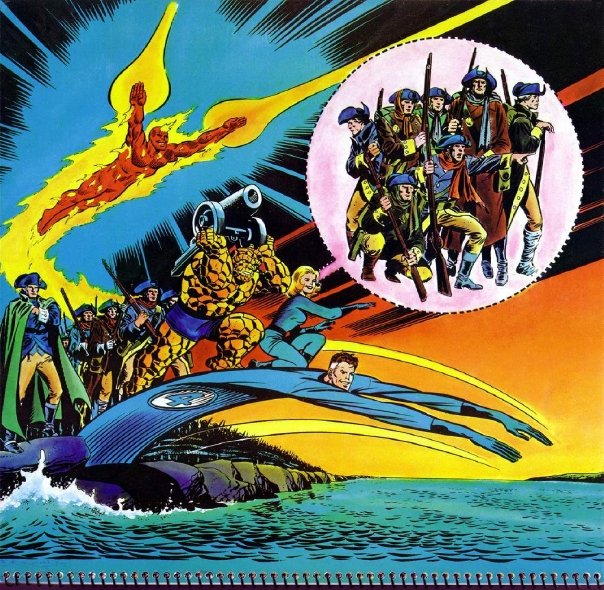
-
The horsemen
Issue 3 has the Biblical theme of the four horsemen
of the apocalypse, and the art by Buscema and Sinnott
is lovely. But there isn't much tension (the bad guys
are easily defeated). A single issue is not enough to
make us care about the new characters.
-
Madrox:
Issue 4 introduces Madrox the Multiple Man, a
character later taken up by the X-Men comics. It was
written by Len Wein, who left the regular book after 157 (to focus on
Giant Size X-men 1 among other things). The Madrox story was actually
originally going to be part of Wein’s run, but when he left it went into
the Giant-Size run instead.
"My original name for the character
was Jamie ZERROX (Zerrox, the Multiple Man. Get it? Boy, was I clever in
those days. :-) ) When I passed the name by then Editor-in-Chief Roy
Thomas, he looked at me like I had three heads. 'You’re kidding, right?'
he said. 'Who’s gonna pay off the huge lawsuit, you?' 'But it’s not
even spelled the same,' I said. 'Not happening,' said Roy. So I came up
with a bunch of alternative until I came up with Madrox, that sounded
like an action word, and thus it has been ever since." (- Len Wein, via Brian Cronin's Legends series)
More to follow... one day.
|
151
Issue 151: no longer bickering children. Adults, friends.
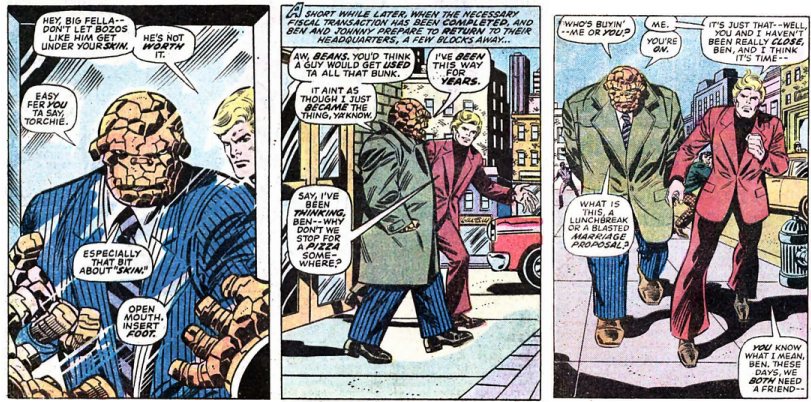
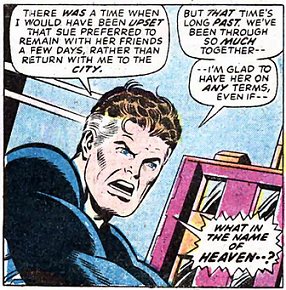
After the immature outburst of FF145, and seeing the woman he
loves marry, Johnny wants to stop acting like a child. He's 24
years old: no longer a youth.
The zeitgeist: feminism
FF151-153 reflect the mainstreaming of feminism in the early 1970s.
This is after the Vietnam war and Watergate, when tension and
mistrust for your own side is in the air (as opposed the anti
communism of the previous era). In past versions of these reviews I
barely mentioned feminism: the message is so in-you-face that I took
it for a given, not worth mentioning. But that's maybe because I
grew up in the 1970s and this version of feminism is all so
familiar. But it's probably worth mentioning. This was a big deal at
the time, so is taken to comic book extremes to make a very clear
point. Conflict bad. Equality good.
"Mahkizmo" is of course "machismo," a Spanish word meaning a belief
in the supremacy of men over women. Whereas Thundra's "femizons"
combine "feminine" and "Amazon" (the legendary tribe of female
warriors).
Gender reversals
"The first scene in this issue is Reed and Johnny buying
nice clothes for themselves. This is a scene that has opened more that
one issue of the Fantastic Four, although it has usually been Sue who
been buying the clothes. So this is a foreshadowing of what will
continue to be a theme of gender role reversals and reinforcements in
this storyline." - FF1by1
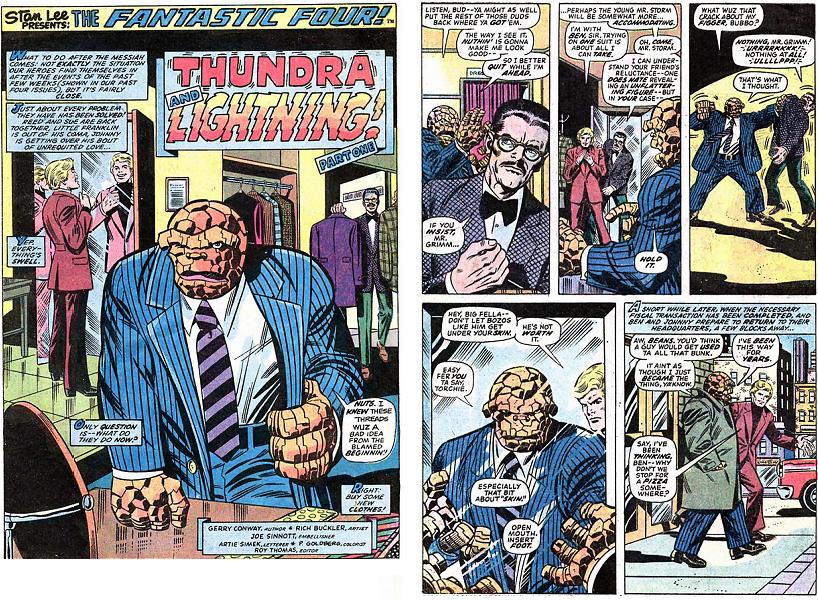
Too simplistic?
"Conflict bad, equality good" may seem obvious but the message
still isn't getting through. We still have conflict and inequality
so obviously it still needs saying. Most people still embrace
inequality based on accident of birth: e.g. "it is right that I
have move money and more choices than you, because I am born
American and you are born Somalian. yet it sucks and in an ideal
world it would be different but we can't do anything about it, and
opening borders would be disastrous." This is the same hand
wringing once used for racism, sexism and other forms of
prejudice. This comic makes the men and woman not just support
inequality but embrace and celebrate it, showing how wrong it
really is. Similarly for conflict. The fact that many people
prefer comics with more fighting (rather than solving problems
through dialog) shows that deep down we enjoy conflict
really. Mahkizmo is us.
Sue and Feminism
Sue is spending time away from Reed, getting to know how she
feels. Yes, she has come back, but it will be on her own terms
now. The time away has been vital. In the past she was dependent
on Reed and didn't know why better. Now she is learning
independence. This is not the kind of comic book where the past is
forgotten. The past has consequences and the problems have not
been resolved. This sequence from Giant Size FF 3, set after 150,
makes it explicit that Sue is still with her friends' ranch in
Pennsylvania, where she will stay for a few weeks until she feels
ready to share a house with Reed again.
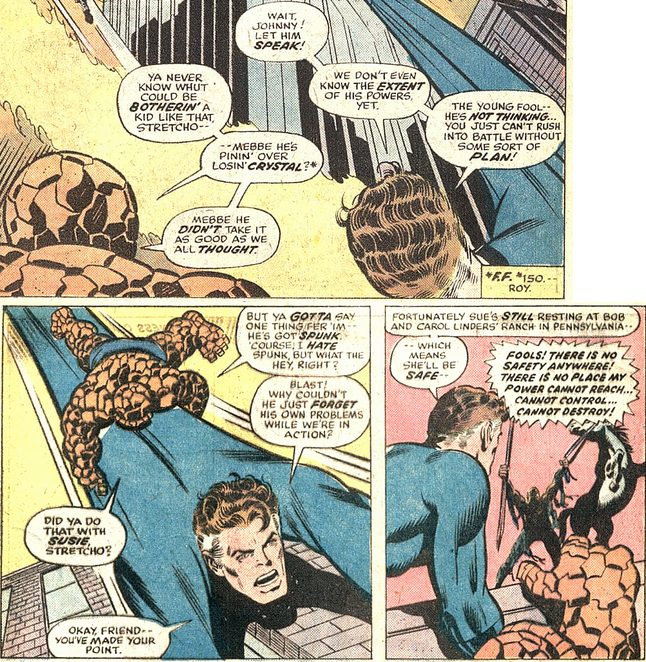
The zeitgeist: nuclear power
In early 1960s nuclear power was associated with infinite potential:
Spider-Man, the Hulk and Daredevil gained their power from
radioactivity. By the early 1970s this had changed. Being called
"The Nuclear Man" now signaled danger.
The zeitgeist in comics: Firestorm the Nuclear Man:
Mahkizmo "The Nuclear Man" is created by Gerry Conway. The story was
about realities merging: the extreme male and extreme realities were
unstable and had to merge. He finally dies in FF153 (spoiler!) when
Thundra (the ultimate female) is merging her hand into him (the
ultimate male) at the crucial time, while Ben hits him. Four years
later (in 1978), Conway created a much more famous character for DC:
Firestorm, "the nuclear man." And what was special about Firestorm?
"He is distinguished amongst
superheroes because he is [...] two normal human beings when
non-powered who then combine in 'super' mode to form Firestorm"
(Wikipedia)
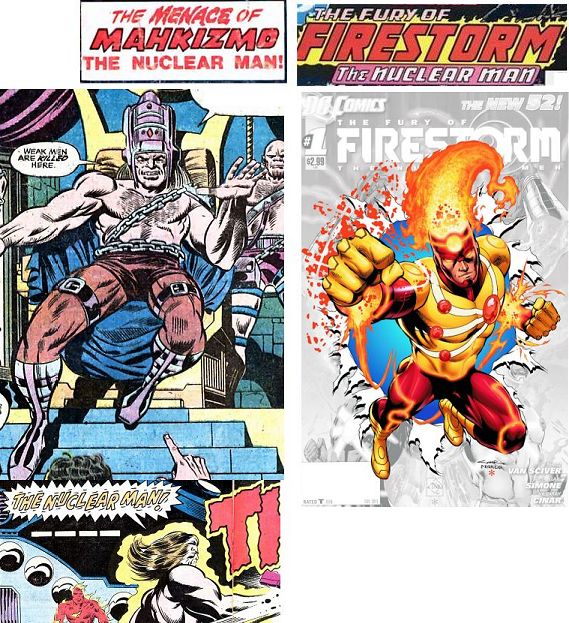
Mahkizmo is just one example of the zeitgeist: the whole point of
the zeitgeist is that it is everywhere. Merging of minds was also a
theme in Captain Marvel at the time. Firestorm also had similarities
with Spider-man, But this web site is about the zeitgeist in the
Fantastic Four, and it's all here. To illustrate, every element of
Firestorm was also present in the FF.
The boots, thighs, chest stripe and headpiece are similar in both
costumes, but Firestorm is more closely modeled on the similarly
named Firelord, a character Conway would create a few months after
Mahkizmo, in Thor comic. (Firelord later appears in flashback in the
FF, in FF173 and FF211.) The idea of two people merging into
one is in Mahkizmo, but the idea of them remaining as a composite
being is the basis of the Overmind and Stranger characters (circa
FF115-117). The idea of two individuals with opposite personalities
talking in the same head is in FF188, when the angry Molecule man
shared Reed Richards' mind.
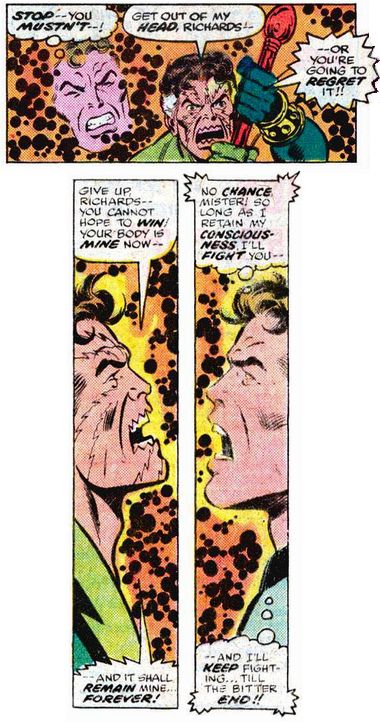
The Molecule man, a guy with normal level intelligence, has chosen
the athletic body of a boxer. Now he was sharing the body of a
brilliant physicist, Reed Richards. This was a major event, the one
that persuaded Reed to finally leave the team. The issue was one of
fan favorite Perez' best, with a striking cover, so Conway could
well have read it. That comic was dated November 1977, on sale
around September 1977. Firestorm first appeared in an issue dated
March 1978, on sale around January 1978, so it would have been
planned around October 1978, or probably a month earlier (September)
as it was a new title. In other words, the exact month that Reed's
shared mind appeared on the stands.
Firestorm's main power in that first issue? "Firestorm flies out and discovers
that he has the ability to alter the molecular composition of any
non-organic material." (source)
Exactly the same power, and the same limitation, as the Molecule
Man. The names of the principle characters? Reed Richards and Klaw,
er, no, I mean, Ronnie Raymond and Kliff. I mean Cliff. Completely
different names. And Firestorm, gets his powers in a nuclear lab
accident, totally unlike the Molecule man who got his powers in, er,
a nuclear lab.accident. But he's flaming, see, and goes to school,
and has a girlfriend called Dorrie... I mean Doreen. Totally not
like anybody in the Fantastic Four at all, no sir!
It has often been noted that Kirby created Challengers of the
Unknown for DC, then moved to Marvel and did the same thing but in a
more popular form. With Conway's nuclear man (based on Mahkizmo with
Firelord's costume) DC returned the compliment. In both cases of
course the best comics are simply reflecting the zeitgeist ad the
writers are almost certainly unaware of specific causes. They simply
channel what they see, mixing it together in random ways to see what
works.
(Notes:
The Molecule Man was first defeated because he tried to control
the molecules of organic matter and could not. Although he later
worked out how to, his FF188 defeat was almost a carbon copy of
his first defeat but this time because of the unstable molecules
in the team's costume. Regarding one extra month being too little
time for a completely new title, that is true, but to be green lit
they just needed the concept: Mahkizmo plus Firelord, though
Conway probably didn't consciously plan it that way. The details
of the origin would be worked out when it came time to plot the
first issue. Captain Marvel and Rick Jones sharing a mind would
also be an influence, but Reed Richards is a closer match as they
share bodies and are also opposite personalities. It's OK, Gerry,
I'm yanking your chain, there are coincidences everywhere in
comics, it doesn't prove anything. Besides, you invented Mahkizmo
and Firelord. They're great ideas so why not refine them?)
The 100 issue cycle
Here we have another dramatic example of the 100 issue cycle:
- FF52 famously introduced the negative zone and dimensional travel.
- FF151-152 features cross dimensional travel, using an image of Reed navigating the Negative Zone, taken from FF51.
- FF251-256 feature a new "improved" portal and journey through the Negative Zone.
- FF351 is a study by Kubik, the expert on higher dimensions (see
the backup story to FF annuals 22 and 23). FF352 is the famous time
jumping story, followed directly by FF353-4, the story of the Time
Variance Authority and colliding dimensions.
- FF451 (volume 3,22) is about a "chaos storm" of colliding
dimensions (see FF453 /3:24 for more). It is the issue where we discover
that Valeria's DNA has the same Negative Zone markers as Franklin (as
well as the same DNA Sue, as far as can be told), thus proving she is
Sue's daughter. Franklinverse dimension-jumping chaos later follows a
different dimension where Valeria is unborn, and then Doom has to use
his sorcery to ensure she is born. For details see the discussion of Valeria and of time travel in the notes to FF272.
152
Issue 152: Reed tries to be softer, more gentle.
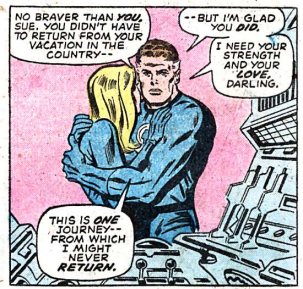
This issue continues the battle of the sexes: a war between a
planet of men and a planet of women (see comments on the previous
issue). In this issue Reed tries to be more tender. Note the
contrast: Reed is not a machismo, he doesn't think men are
superior to women, oh no sir. Not Reed. But next issue he tells
her to stay behind while the others go off fighting. he tries it
again in FF158 and that is the last straw: FF159 changes
everything.
Let's hope Reed's new approach lasts.
Why such a short review?
There isn't much to say because this is almost a fill in issue:
according to an apology at the end of this issue, and the letters
page of FF156, this issue almost didn't appear. It was completed a
mere three weeks before it appeared on newsstands. The last image
of The Thing is unforgettable for its awfulness. It holds the
record for the worst drawing of the Thing ever. It was clearly
drawn in seconds then rushed off before the ink was even dry.
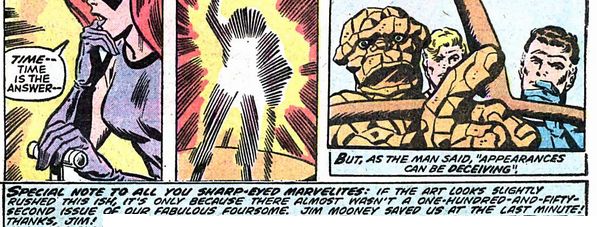
In interviews on the now defunct "FantasticFourHeadquarters" site
the creative team expressed embarrassment about this arc. But the
glory of the Fantastic Four is precisely its rushed nature: when
in doubt they just grab some obvious cliche and barely change it.
But a cliche is a cliche precisely because it reflects the
zeitgeist. Extreme feminism was a real concern for many at the
time. These cliche are s window into the America of 1974.
Other points to note
- The letters page to this issue is historic: a large proportion
of fans asked for Sue to leave or at least divorce Reed. They
agreed with Medusa that Reed's zapping of his son should be seen
in isolation and therefore was justified.
- Due to the rush Reed has a hand at the end of his leg on the
splash page. This is part of a pattern: click for details.
- This kind of rush was common before Jim Shooter took over in
1978. Shooter abolished the role of combined writer-editor, thus
ensuring that at least somebody else is breathing down a
writer's neck and isn;t too likely to accept excuses. He also
insisted that there were inventory issues ready to replace any
late comics so there would never be any more reprint or rushed
comics.
- Reed's headphones:
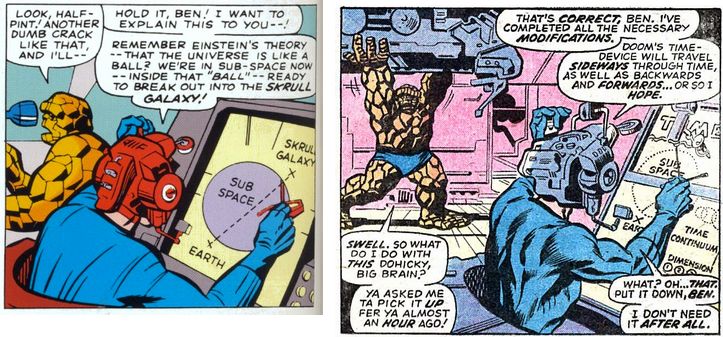
Like many programmers, Reed wears headphones to remove
distractions (often there is no music, but wearing headphones
when programming discourages other from chatting to you unless
it's important). Note that Reed is so focused on his project and
unaware of others' needs that he lets Ben carry a weight
for almost an hour, even though it isn't needed. This also shows
Ben's underlying caring nature, that he would take that kind of
treatment from Reed. And note of course that Rich Buckler at
this early stage routinely copied from Kirby. All artists were
encouraged to do this but he took it more literally than most.
Note also that "time" looks very much like the Time magazine logo,
then a very important upmarket magazine.
153
Issue 153: being ultra male
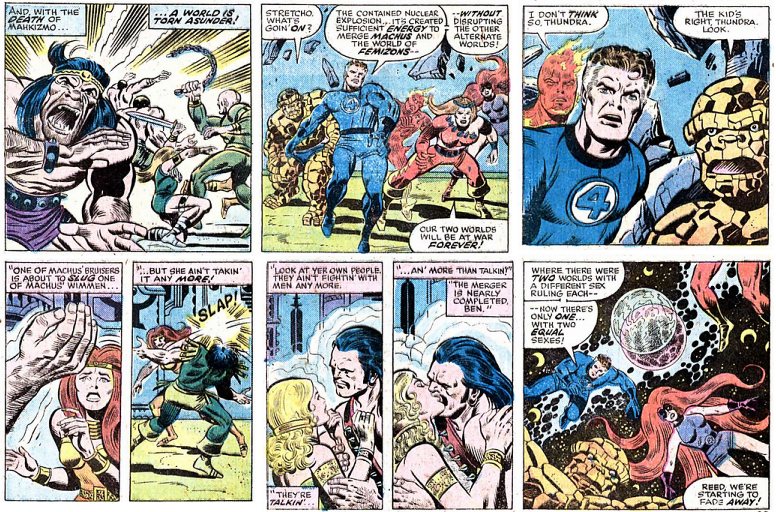
This issue is about extremism. What happens if you take what makes
you special to its extreme? Disaster. What's the solution? Treat
others with respect: their unique differences matter as well. The
story is about male and female but it applies to all differences.
Reed's difference is his ability to focus his mind. Reed is probably autistic,
and the autistic ability to focus (at the cost of being socially
limited) is sometimes called "hyper male" because this is normally a
male trait. The other famous male trait is of course violence. Here
we see both traits at their extreme. Women can be autistic too: it
does not mean autistic women are male, any more than a sensitive man
becomes female. The idea that sensitive men are female is mocked in
this story: only the most ignorant and violent men think that, and
their violence destroys themselves.
The story ends with the cliche that love solves relationship
problems. It's a cliche but true. It's what Reed needs to do with
Sue: show that he really cares, and treat her as an equal. In FF
158-159 they will come to a new status quo were Reed may is no
longer the boss of the marriage.
Criticisms, and superhero science explained
This issue was slammed on the "slay
monstrobot" blog because the writer could not see how this
could work. So let's have a closer look. All the clues are in the
comic. One fan explained it in detail but the letter was too long to
print. It was summarized thus:
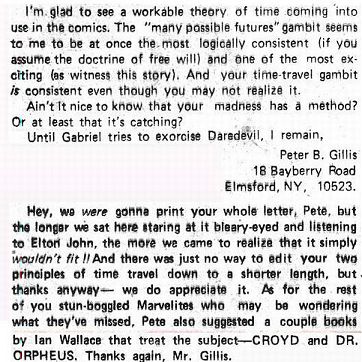
If Marvel had explained everything they would be accused of being
too wordy. Now they are accused of not explaining it! Yet they
gave enough information to work it out. Let's look at what we
know:
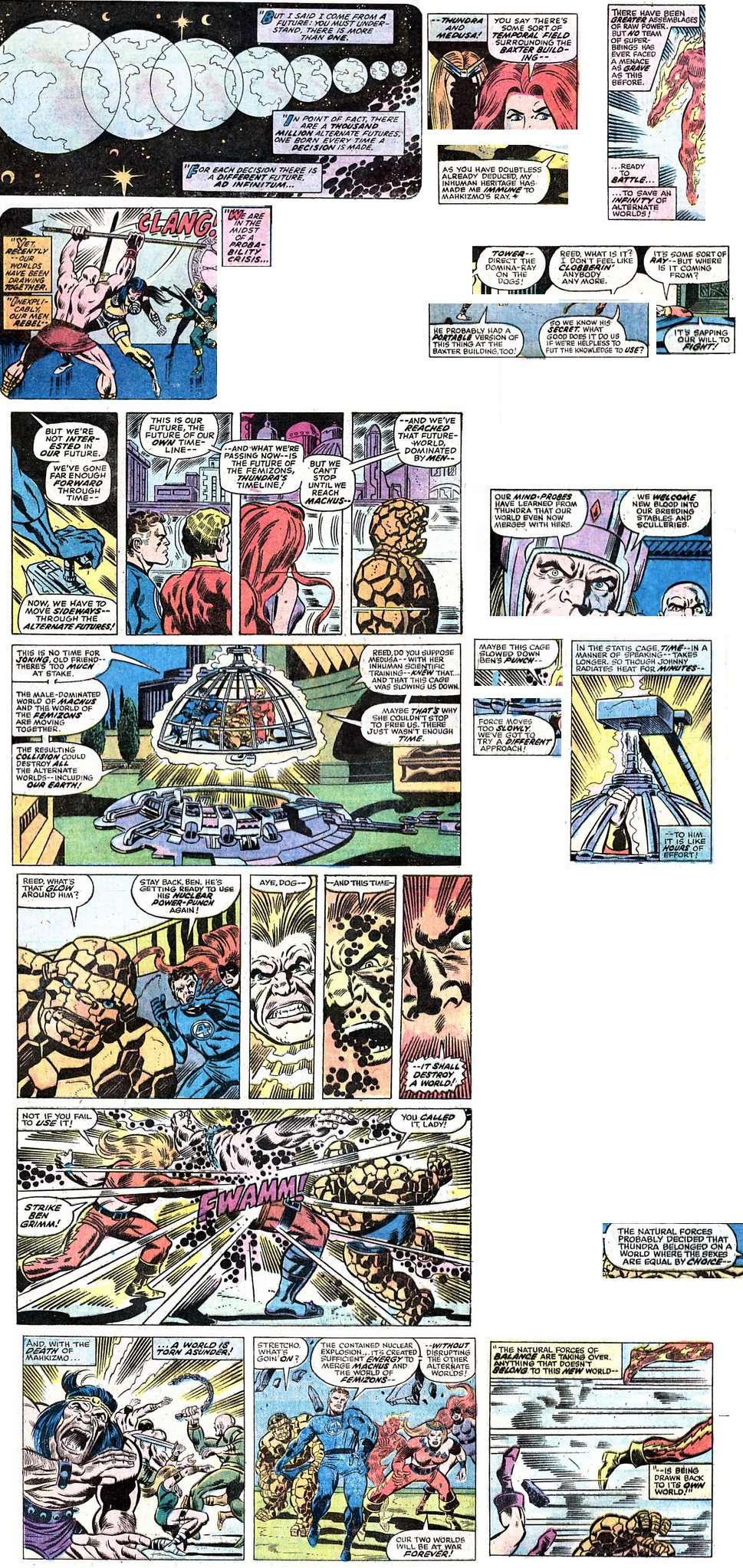
What we know about the dimensions:
- The basic problem is a probability crisis. The future male and
female words are at extremes of probability. This cannot
continue: the time stream has a natural idea of balance: wanting
to merge them back.
- A temporal field attracted Thundra to he Baxter Building -
perhaps linked to the use of the time machine Reed seems
hesitant to use the time machine - he only uses it when he
absolutely has to, despite its ability to go almost anywhere. it
probably causes all kinds of problems with the time stream.
- Thundra's idea to beat the strongest male was probably a
guess: it was the only thing she could think to do to give her
reality a higher probability of existing.
- The fact that a time machine can exist at all indicates
connections between normally unconnected realities.
- Normally the time machine just jump to a reality, but in this
case it stands outside and sees all connected realities pass
by. This suggests that similarities are what connect the
realities.
- Since realities are connected by similarity, and some
realities are too improbably to exist, it is reasonable to
suggest that they might link again.
- Mahkizmo is somehow
endangering all realities. This is the key.
Now look at what we know about Mahkizmo and his friends:
- The future men are not very bright, but very violent, yet use
highly advanced machines: the ones they use must be stolen.
- In particular they have what looks like the Skrull arena and
mind sapping ray
- Consider what links all those powers: the original skrull
arena also had a gravitational device.
- They also have a time slowing device
- Mahkizmo is a nuclear man,
yet does not create explosions in the way Blastaar
does. Reed calls the final explosion nuclear yet it caused no
conventional damage: it simply kills Mahkizmo and merges
realities.
- He somehow uses force (hitting people) to weaken people, but
not in the usual way.
- At the end, merging realities affects the people's thinking.
Also, Thundra's different thinking dragged her to a different
world.
Now recall what we know about different dimensions from
theoretical physics
- Time and dimensions are warped by extreme gravity and at
nuclear scales.
- At the nuclear scale, the quantum scale, observing a scene
changes it
- Occam's razor says always reduce the number of elements: if
one element can explain two things use it. It is all linked by some common
technology.
OK, so here is a scenario suggested by the comics. Before the
end:
- Nuclear technology exists that links time and space and the
human mind
- The Mahkizmo's men stole it and use it recklessly.
- Mahkizmo, the most extreme,
is the most reckless; he has somehow incorporated it into his
body. The extreme males have no idea what they are
doing and take many risks. We can easily imagine a thousand or a
million of the wild men dying before one of them gets lucky and
becomes Mahkizmo.
- So they are basically playing with time and space and
dimensions while the forces of nature try to correct themselves.
This probably causes the two least stable (most extreme)
dimensions to try to recombine.
- My guess is that when Mahkizmo hits somebody he causes trauma
to every molecule of their body: moving them all in sightly
different directions dimensionally, just enough to render them
unconscious.
At the end:
- At the end, Mahkizmo is ready to apply the same force to the
entire world. This requires a moment of great instability as he
prepares.
- Look closely at the moment when he is defeated: it appears
that Thundra, the ultimate woman, had merge her hand inside the
unstable ultimate man. This combines the mental focus of the two
unstable realities that were previously trying to merge. She
then orders Ben to hit him: this creates a shake up far greater
than Mahkizmo had planned.
- The effect is perhaps similar to aligning iron to the Earth's
magnetic pole then hitting it hard, creating a weak magnet
because a few particles then settle back into alignment with the
field rather than at random as before. With Mahkizmo instead of
charged particles we have all possible positions of a quantum
field of particles. Hitting him at his most disordered and
neutral state forces this field to collapse into its most
ordered state. This kills Mahkizmo, who's extreme improbability
can no longer exists. Like a magnet, the now ordered probability
influences connected probabilities and orders them as well:
people become less extreme, like the poles of a magnet combining
and becoming neutral. OK, it's a tortured analogy but it's the
only way I can visualize it.
Put simply...
Think of all realities as a big box of sand. Mahkizmo has
technology (that he does not understand) that shakes this box up
by hitting it. He can make it all shake in one direction or
another. But if it is merely shaken at random then it all settles
neatly at the bottom of the box in an ordered form.
It is a beautifully elegant story, presenting the most complex
idea in the biggest, simplest way. Here are men playing with toys
and taking risks, shaking things up just to see what happens. They
are the ultimate irresponsible males.
Other criticisms (mostly from FF1by1.com)
- Medusa
"Where did Medusa come from? how did she get there?" The last page of
the previous issue shows that she used Reed's cross time device.
- The Domina-ray
"What is a Domina-Ray and why is it needed?" It comes in very handy when
you live in a planet full of testosterone filled madmen: the ruler need
a way to calm them down. This sounds like a variation on various
devices used by Maximus and Doom: since the technology is discovered in
our time it is probably commonplace in Makhizmo's future.
- Why did Thundra come back to Earth?
She was sent here before: her scientists did something to her to make
her come here, so when the dimensions were shaken up that was her
natural destination.
Other points to note
- Sexual imagery
Mahkizmo is a serial rapist (when he isn't being a mass
murderer, though he no doubt combines both hobbies). Look
closely at the picture when he is defeated: Thundra seems to
have inserted her hand into his temporarily vulnerable form. Now
he is on the receiving end and cannot cope.
- Tony Isabella and the most rushed story
This, the climax to the multi world story, is perhaps the most
rushed of the rushed issues (not including next issue's reprint story,
obviously (see notes to FF252 and
FF254). Back Issue magazine 74 wrote:
"FF153 was running very late when Tony
Isabella was given the job of finishing the multi issue by Gerry Conway
and Rich Buckler. The issue identified Isabella as the scripter which
implied he only wrote captions dialog and sound effects for the existing
art."
Karl Disley writes:
"Not true. 153 was running very late
so the afternoon he [Isabella] received the assignment to write the
issue he co-plotted the issue with Buckler. There was no existing plot
for how Conway had intend for the story to end and no art had been drawn
for that concluded issue. For the next three days it went as follows:
Buckler would bring in pages and Isabella would script them overnight to
be sent out for lettering the next morning. Joe Rosen would letter them
and send them directly to Joe Sinnott for inking. There was no tine for
any substantial changes to any stage of the process as the printers
beckoned. The entire issue was completed in four or five days as opposed
to the normal 11. Isabella's credit for FF153 is properly co-plot and
script.
This climax issue is early Rich Buckler trying to go all super Kirby
with Kirby monsters, Kirby dots, Kirby bad guys and so on: it
doesn't have Kirby's style but has its own sincere energy.
Buckler really comes into his own in later issues - FF158 for
example.
- Fan trivia
The letter about time travel was written by Peter B Gillis. Four
years later (in 1978) he was writing professionally for Marvel,
including the Dr Doom title "Super Villain Team Up." ""The revival and annual
publication of SVTU was part of the legal maneuvering on
Marvel's part to keep DC from trademarking the term 'Super
Villain' as in 'Secret Society of'. For that, annual
publication was enough, and by the second year, the legal
tussle was resolved." (Back Issue 66)
- Zardoz
Those Machus men look familiar. Remember the cult "so bad it's
good" classic movie Zardoz. Starring Sean Connery, it came out
in 1974, just before this issue was prepared. It had a similar
plot: a post apocalyptic future full of violent men (the
Brutals) in conflict with powerful women (Eternals). Jack Kirby
was famous for recycling movie ideas in his later FF issues, and
Gerry Conway (or Tony Isabella) seems to have done the same.
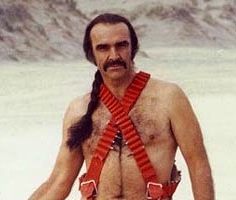
154
Issue 154 (mainly a reprint)
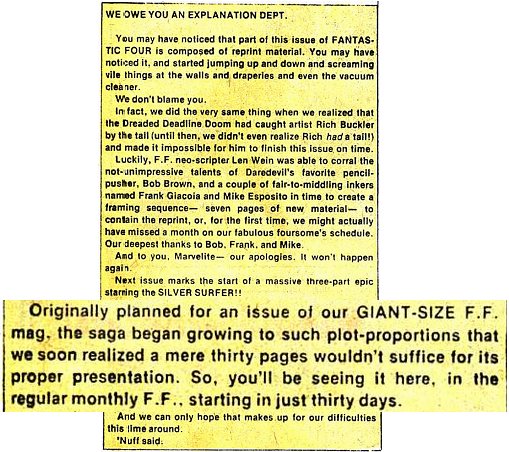
At this stage the comics were running very late, almost missing
deadlines. So this one used a reprint and just a dded a few pages
of quick padding at each end. it's not really part of the big 27
year story.
This is the first ever FF reprint, and it allowed the next story
some breathing space: FF155 could not be rushed, it's too
important.
155
156
157
Issue 155-157: the biggest FF story ever
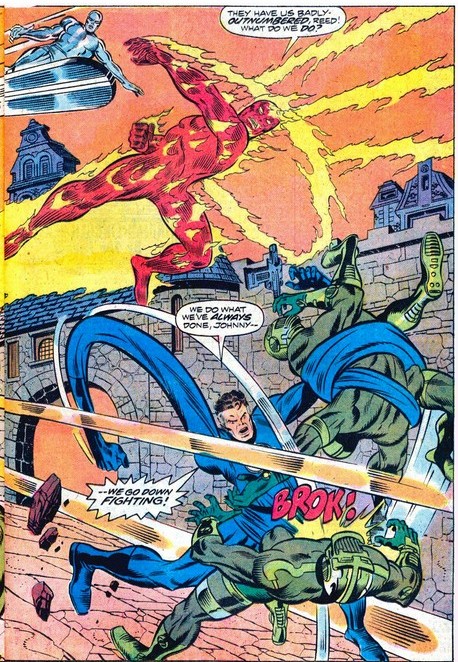
Here we take a well deserved break from all the angst, to
remember that the Fantastic Four can be a whole lot of fun. Don't
worry, the stress returns with a vengeance in FF158. This still
pushes the big story forwards, but mainly through secondary
characters:
- The Silver Surfer deepens as an individual (Shalla Bal
appeared in the surfer's own comic, but this is the first time
we see her in the FF)
- We are introduced to Mephisto, who will play an important role
toward the end of act 4.
- Doom recovers from his low point in FF242-43: his power comes
from his relationship with his people (just as Reed needs his
family to function). This story is based on the streets of
Latveria and Doom has more dignity. His focus on art is another
indicator: in FF243 he just used it as a way to make fun of
Reed, but here he loves it for its own sake.
The Surfer's secret is finally revealed
This topic is so big, so deep, that it has its own page.
The message: layers of meaning
The Fantastic Four stands out from other comics because of its
multiple layers. That is the theme of this half way point.
- On the surface it's just super heroes hitting each other. Most
stories last one or two issues.
- Look deeper and it's about family: relationships and trials
may last several months or even years.
- Look deeper still and it's a 28 year story with a beginning,
middle and end.
Layers feature strongly in this story
- The surface appearance, where Doom finds his beloved Shalla
Bal
- Doom's deeper layer, here it's all a trick
- Mephisto is the deepest layer of all. Each layer is unaware of
the one beneath it: Doom would never accept the possibility that
someone else controls him.
- The question then is what lies behind Mephisto? Well, Franklin may unconsciously influence
everything. We see in FF277 (and again in annual 20) that
the only being Mephisto fears is Franklin. And that layer is so
deep that even Franklin doesn't recognize it.
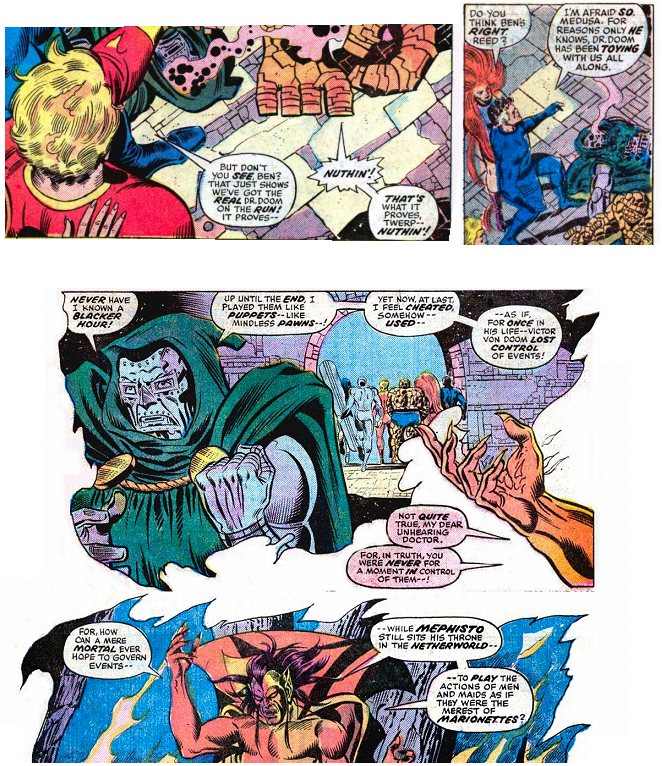
Themes
This is a milestone issue, so it's worth pointing out the major
themes again (usually I avoid spelling them out but they are
always there):
- Reluctant heroes:
Sue is not even there: she had to be
replaced. Johnny, though here, wears a different uniform to show
he is not comfortable with the set up (he returns to the team's
uniform when Sue becomes dominant in FF159), The Surfer is
trapped in situation he never wanted, without a home (see the
last page in particular).
- Self confidence:
the whole story is a riot of self belief:
these four friends can overcome anything that's thrown at them!
In particular, Ben is intelligent (fighter pilot) and can show it when
not overshadowed by Reed. Doom cannot imagine that to be the case.
- Equality:
the most powerful ruler, Doom, can be beaten, and in
fact he's just a puppet of a higher power. meanwhile the weakest
person present, Shall Bal, is potentially the strongest: the
Surfer will do anything for her.
- The American Dream:
four Americans bringing justice to a
tyrant's country. Also a lowly peasant can find she is really a
princess. Yes, its; fairy tale stuff folks.
Foreshadowing
This is a milestone story and foreshadows the very end:
- This, the biggest story, is effectively the half way point in
the 28 year story (the actual half way point is 162, but who's
counting?).
- Compare annual 20, and note the levels of control: surfer <
Doom < Mephisto < Franklin
- These multiple layers of control foreshadow the Franklinverse:
the dreams within dreams spelled out in FF330-332, which in turn
foreshadows the many years to follow.
- Note the length of the "Reed losing power" sub plot: from
issues 157 to 200 (or 140 to 200 if we include Annihilus'
actions that he said would cause a delayed reaction). This is perhaps
the longest subplot that did
not begin in Act 2 or before, and does not have gaps (e.g. the
Frankie subplot)

Criticisms
- Why does Doom use over-elaborate traps? Why not just kill
them? See notes by FF17:
Doom's goal is to prove his superiority, not kill them, though
he might kill them in the process.
Other points to note
- The 100 issue cycle
Doom attempts to control the Power Cosmic three times, each 100 issues apart. Each builds on the previous ones.
- In FF57-58 he diverts the Surfer's own energy
- In FF157 he attempts to duplicate it for a machine
- In FF258 he attempts to duplicate it for a person
- Zugzwang
The title to part two is
"Zugzwang" Roy says "look it up." It's "a situation in which a player is
limited to moves that cost pieces or have a damaging
positional effect." (source)
- Realism: what it would really be like
"I love how the thugs call
Ben 'fatso' before he turns around and they see who he is.
Back in the day, the Thing always seemed of average height,
say 6', but he was incredibly wide and massive. He didn't have
the usual proportions of a super-hero. I like that." (source)
- Importance
This is the biggest Fantastic Four story of all, split over
three issues bigger than the triple sized 236 and 296. Issue 600
is technically larger but it comes from a time of decompressed
stories where much less happens on each page.
- Why combine the reviews?
156, called "middle game" is the only issue where a title
admits that it is not complete. For that reason, these three
issues are treated as a single unit in this review. I am
not a fan of stories where you only get a chapter: I want high
value for for my hard earned money. But this case, like
FF212-213, is a rare exception: the quality of the story and art
mean I will happily pay three times for the one story
- Humor
"Did you notice Johnny
saying they would take down the Doombots in 'one swell foop'
rather than 'one fell swoop'?! I'm just wondering if that was
a mistake, or if Thomas/Wein were trying to make a comment on
Johnny? He never did finish college...." (source)
Or this could be his sense of humor, perhaps a phrase current in
the early 1970s.
- Realism: the role of
priceless art
How the battle suddenly ends: "in
came Shalla Bal (or should I say Helena, who she claimed to be
-- used by Doom as a doppelganger to get the Surfer under his
control), and her cries against wrecking Castle Doom were
immediately heeded. What's that, you say? Some girl stopped
Marvel's flagship super-team from pounding Marvel's greatest
menace, just like that? Yep. And on account of saving the
cultural history of the nation of Latveria, stored in Castle
Doom. Although I had a big case of "what the?!?" as this
unfolded, I was taken back to some curriculum work I'd done
for a film entitled The Rape of Europa. That documentary is
about the Nazis' heist of priceless works of art during WWII,
and their careless regard for timeless, priceless treasures
including works dating to the Renaissance. So with that in
mind, I thought her pleas were appropriate." (source)
- Priceless art, again
This also reminds us of the ending to FF87: once before, Doom
lets the heroes leave after the castle art is threatened.
- Doom's limits
Doom is petty, trying to prove himself: then in an act of sour grapes he
says he does not want the surfer's power. Probably in reality he cannot get it: the surfer will not let himself lose his power, so this time Doom must analyze it to duplicate it instead.
- Literary references
- Doom refers to the the image of a boot tamping endlessly on a face - a phrase from the novel 1984.
- Ben refers to the rhyme "London Bridge is Falling Down"
- "Laughter in hell for about the space of half an hour" is a
reference to the book of Revelation, where at one point there is silence
in heaven for half an hour
158
Issue 158: Sue wants to be a detective
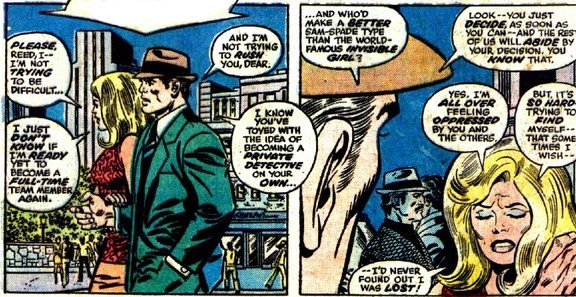
Much could be said about this issue, but one fact stands out: we
finally get an idea of what Sue would do wither spare time: she's be
a private detective. It makes a lot of sense:
- It fits her powers perfectly. Far better than being a super
hero.
- Her father went to jail, unjustly, and died because he was
impersonated. She will have a natural interest in the legal
system and in uncovering truth.
- Time and again she has seen the team waste time or do the
wrong thing because Reed didn't consider all the possibilities
(e.g. FF220-223): Sue knows the value of standing back and
looking for overlooked clues.
- It would allow her to mix with society friends (see FF1):
gathering information from those with connections.
- She is later shown making invisible keys (e.g. in FF196 and
FF224).
- She is naturally reserved, preferring to stand back and watch.
- Her life with Reed has shown that people have hidden
weaknesses and are not always as they seem.
- She is good at seeing the big picture and has superb
intuition.
- Her life has told her to keep secrets: not to just say what
you think. As a teenager she had to raise her brother, so had to
be responsible. She did not want to talk about her father in
jail. She dido not feel able to challenge Reed intellectually.
So she naturally keeps secrets and sees the bigger picture.
- Her greatest triumphs have been when investigating in secret
when told to stay home: rescuing the Latverian village (F87) and
the next issue (FF159) for example.
Sue is the perfect detective. This recent cover to Shield 4 is what a Sue solo series should look like, IMO.
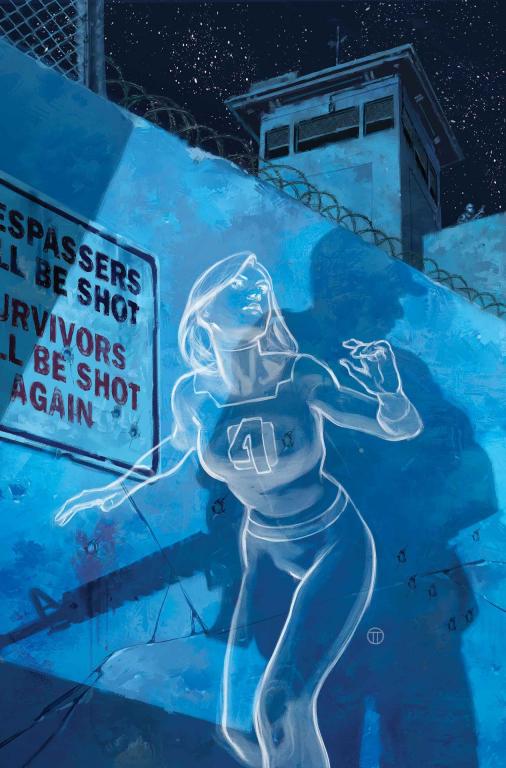
This issue is crucial to understanding the depths of Sue's mind: she
only says what she feels is appropriate, but under the surface
there's a lot more to her. She really is invisible to most people.
Other points to note:
- The classics
The bottomless fountain leads to "caverns measureless to man" - a quote from the poem Kubla Khan
- The underground river
For the psychological symbolism of the underground river, see the notes
to FF314: this is is where Sue is about to finally assert herself and take over (see next issue).
- Scientology: copied from Marvel comics?
Scientology was growing in the 1970s, so it might be worth looking
closer at the name Xemu. Xemu was an alternative spelling of Xenu, the
slirn being made famous by scientology. According to Operation Clambake
(a message board for ex-scientologists), "Xemnu the Hulk", later called
"Xemnu the Titan", first appeared in Journey into Mystery #62 & 66
(Nov. 1960 & March 1961). In 1967 Marvel Super-Heroes reprinted
Journey into Mystery # 62. Soon after, in December 1967, L. Ron Hubbard
wrote his first he Xenu story. L.R. Hubbard contributed to Amazing
Stories and Astounding. In fact, Dianetics first turns up in Astounding
195 # 4. The Xemu in FF158 is not the same as Xemnu the Titan, but all
three versions of Xemu seem to be alien overlords with an interest in
populating others' worlds. Whether there are other coincidences is left
as an exercise for the reader.
- Sue's costume
The letters page discussed possible new costumes: a couple of years
later (in annual 12) Sue herself wonders. This reflected the changing
status of women in America: a woman can now wear whatever she wants, but
does she really want to? And what message will that send?
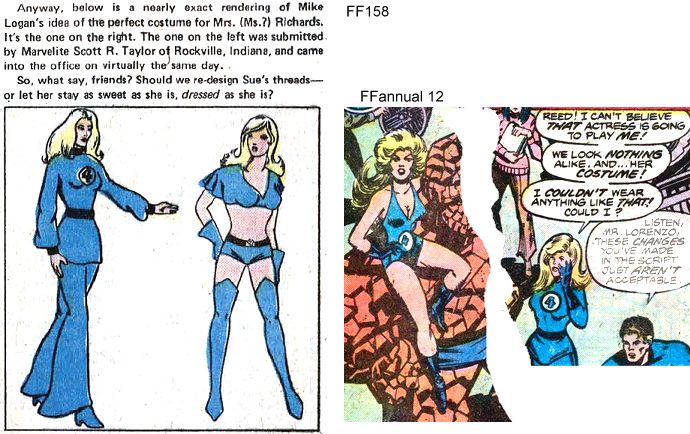
- Twinkies
This had the first of the classic Hostess Twinkies ads: there would be 74 of these beauties, the last one published in FF241
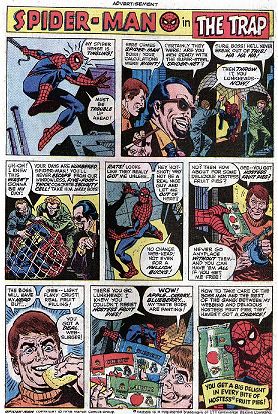
159
Issue 159: the turning point: Sue takes over
The previous issue told us: this is a turning point

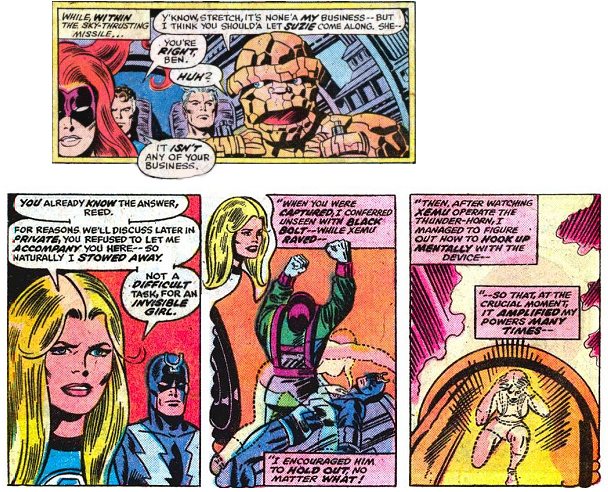
The first half of the Great American novel is dominated by Reed. The
second half is dominated by Sue:
- This issue is almost exactly half way through the 321 issue
great story, and close to half way to FF307 where Sue finally
wins.
- It is intended as a major turning point: at the end Medusa
leaves, Johnny gets his blue costume back, and Sue and Reed vow
to start again to try to make things right this time.
- This is the issue where Sue, having endured the last straw of
being treated as weak in the previous issue, saves the day in
her most spectacular way because the others (including the
patriarchal king Black Bolt) fail so miserably.
- This is the issue where Sue gets a major power-up thanks to
the thunder horn while Reed is confused and helpless (note the
phallic symbolism).
- This is the issue where Sue finally takes charge, but in her
own, almost invisible way. From this point Sue is the stronger
character. But as usual she leads through humility, through
service, through making the others feel stronger. But watch
closely in the following issues: it's Sue in control. When Reed
wants t hide it's Sue who brings him his uniform and tells him
to wear it. When Reed gives up and shuts the tam down it's Sue
who plans to reform it. When Reed defeats Doom and says they
don't need the team now it's Sue who tells him he must carry on.
After that she has him more where she wants him, wearing normal
clothes and spending time with his son (Doug Moench's run) but
it wont be enough. So it will be Sue who tries her final gambit
in FF232, Sue who drives the team forwards when Reed disappears
and is sent to trial. Sue who finally makes Reed put Franklin
first in FF307. Beginning this issue Sue is the Queen on the
chess board, the most powerful player on the board, while Reed
is the chess king, merely a weak figurehead.
- Last issue, when facing his manliest enemy, his great rial, he
begins to feel weak, begins to lose his stretching ability. He
feels emasculated. It will be downhill from here.
- Reed spends the next year (his time, three years our time) in
decline, losing all confidence, then has a brief false dawn, a
year trying to hold it together then a year being suicidal until
finally he admits defeat and Sue wins, And he did it all to
himself by his stubbornness: never once was Sue anything but
loving and supportive.
- The turning point is her Pennsylvania retreat. The time at
Carol's ranch gave her time on her own for the first time in her life, without Johnny
or the team to worry about.
- Most fans see her becoming Malice in the final days of act 4
as the major change, but that was a mere footnote, as far as her
developing personality is concerned. It was just a symptom of
the utter chaos and evil at the end. But this, FF159, is where
the new Sue appears.
- Sue will still let Reed make decisions, because Sue is not
out to defeat anybody. She has always recognized his
intelligence, and (as she points out next issue) that his
patents finance the team. But from now on, she can make him do
what she wants if she decides to.
- But will she be up to the job? She has never led before. She
won't have the confidence to really take charge until the final
year (John Byrne's run on the title)? Until then, whenever Reed
makes a bad decision, Sue may be culpable due to not pushing
harder.
The Valentines issue
Next issue is the start of the new order. It was originally
scheduled to be published on Valentines' day, as the letters page
notes, because the couple have now entered a new stage:
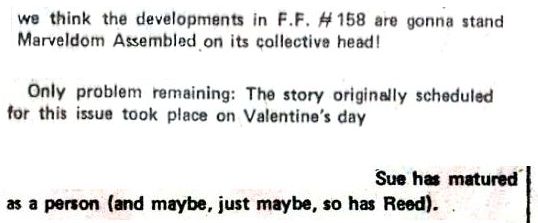
The Valentines date will be referred to three times (though due to
it being written in 1974 for a 1975 cover date the year has a typo
at the start).
FF160 will be where Reed makes one last attempt to prove his
manliness, to prove he is in control, using the fact that he is the
man, the provider, to sell the team because he can. Though even here
he fails totally. he is not providing: his business skills have
failed and the team is bankrupt, he can no longer provide, and his
attempt to sell the team almost causes multiple World Wars. .As
often happens, the title to the next issue refers both to the events
of that issue and to the wider wider importance to the 28 year soap
opera.
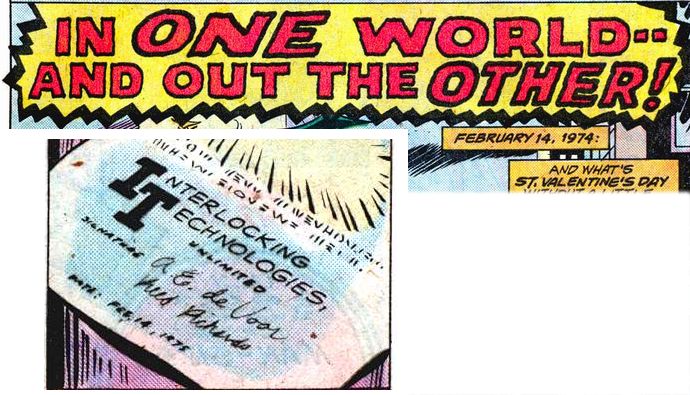
That will be the start of him accepting the new status quo: that Sue
is in charge now
The marriage: its three parts
The Richards' marriage can be divided into three parts:
- 1965-1971: Reed leads
- 1971-1975: (FF106-159) the separate (149-159 they renegotiate
the marriage)
- 1975-1989: Sue leads. Though Reed is still technically in
charge, he is emotionally vulnerable and orbits around Sue
Johnny now feels happier
With Sue now the dominant force, the family is happier. Johnny feels
he is part of the team. But this won't last, as next issue Reed will
make one of his spectacular bad decisions and Johnny will want out.
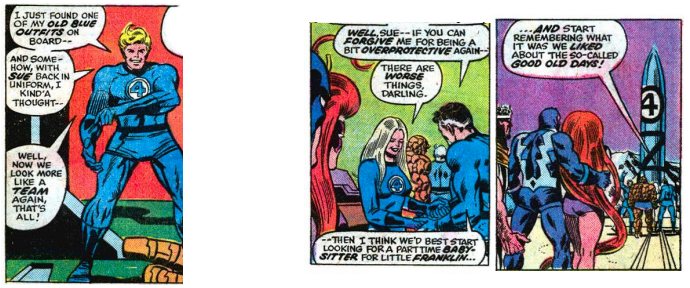
Criticisms
- "I like how Ben said to Reed
he felt Sue should've been with them. Reed's reasons for
leaving her behind just don't wash. Another reason I never
liked the guy! I agree, our heroes are taken down a little too
easily. [Doug gives an explanation:] it obviously saved the FF from making any mistakes
that might cost the lives of the royal family or any other
innocent Inhumans." (source)
- Xemu had put his captives in a flame-proof, draft-proof, and
Thing-proof stone chamber. Ben's best shot only served to crack
the walls and the floor. But when a bit of moisture started to
ooze up, that's all that was necessary for Triton to burst up
through the floor and rescue the FF. What is happening? This is
easily explained: think of how some plastic is easy to tear in
one direction and almost impossible in another. Or how magnets
push one way and not another. Obviously the cell was reinforced,
and to be sure of restraining the Thing you'd need all possible
molecular strength aligned in one direction, not the other.
Cold War zeitgeist
- The bad guy "expected that
the Hidden Land would be laid waste and the Chinese would
assume a plot by either the Americans or the Russians had been
put in motion. Ah -- these were Cold War times, no?" (source)
That cover!
This classic cover was used on a lot of merchandising (and
homages by later comics). "OK, how many of you had this
cover on some of your Mead school products? Folders, notebook
paper? I did not, but boy, I sure looked longingly at that stuff
at the store!" (source)
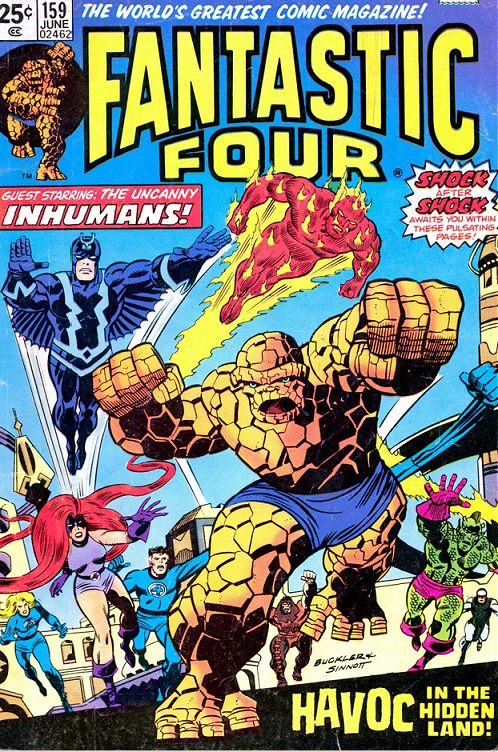
(Here's an earlier version of the same cover: FF158-159 was originally
planned as a single issue, Giant Size FF 5. The final published version
seems to have been re-inked: this is most obvious on Ben's chest):
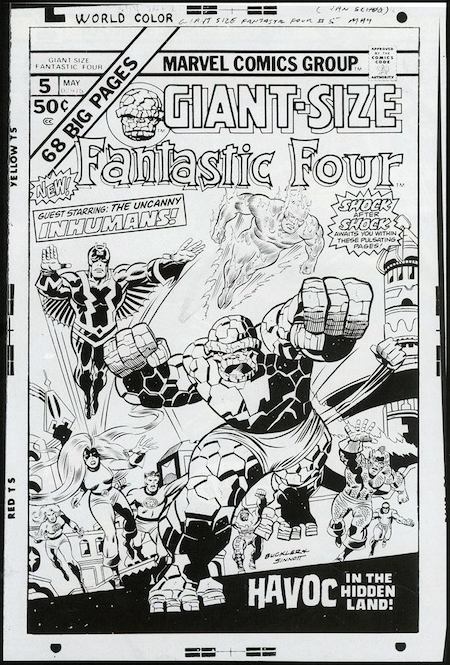
160
Issue 160: the Valentines issue part 2; Reed
incorporates the business
Part two of the 27 story begins here. This issue is a landmark
for two reasons: the family and the team. Major decades long
themes begin here: Sue as the dominant member of the team, the
team as a legal corporation, and hints of Johnny and Alicia. it is
superb story telling that on Valentines day, when their
relationship has just been saved, what does Reed do? Business. Not
only that, but he choose this day to be a complete idiot, opposing
Sue's wishes in a major area, driving away Johnny, putting the
whole family at risk. On Valentines day just after they narrowly
avoided divorce? Couldn't you have waited just one day? Oh you old
Romantic, Reed.
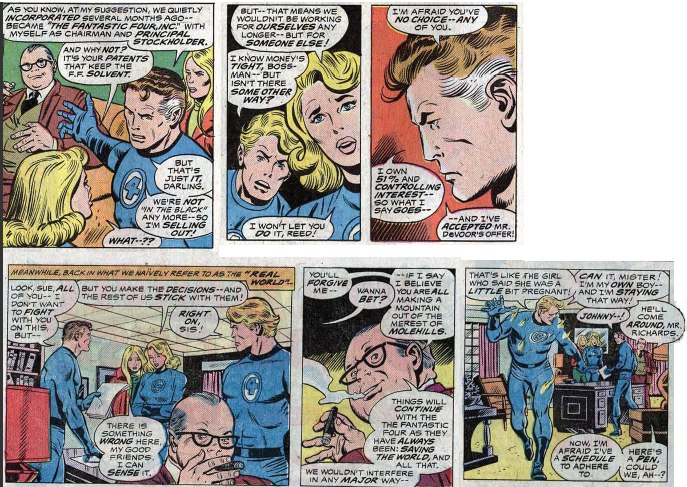
This is an issue about major real change. Sue is back, Reed is
feeling a little more confident, but he doesn't want to feel
powerless again. He hates feeling powerless more than anything (I put it down to autism). So
he makes changes that will consolidate his power and make the team
run more smoothly. He thinks.
The battle of the sexes continues
In this issue, Reed shows he hasn't learned to put his family
first, though he thinks he is doing just that. He ignores Sue's
advice, and thereby helps to causes a war on multiple worlds. Ben
continues to neglect Alicia, and Johnny faces up to what he has
lost by not being mature enough for Crystal. We see the first
foreshadowing of Johnny-Alicia rebound relationship.
Reed's need to make the team a corporation is probably an
unconscious reaction to his new junior place. In reality Sue is
the dominant one now and Reed wants to feel he's still in charge.
The team incorporates
Reed has always had problems with finances: unlike Tony Stark
(Iron Man) Reed is not a natural businessman. We saw this in FF9,
and we see it again now: the others can see that he's making a big
mistake but he ignored them. His pride will be his downfall.
Bob Ingersol explains why the FF had to incorporate in The Comic
Buyer's Guide 519 (October 1983). The key points are as follows:
- Although the FF makes a lot of money from Reed's patents, it
also has enormous costs, mainly from:
- building and running exotic property and machinery,
- taxes on their income
- property damage and related lawsuits.
- Paying zero tax (as a non-profit organization). The team was
always non-profit (see Amazing Spider-man 1, where Spider-man
tried to join and found he would not become rich), but it needs
to be incorporated to get the tax breaks.
- Keeping private wealth safe. Previously the team was a legal
partnership, so each person was partly responsible for costs,
and risked bankruptcy. But an incorporated business means only
the business is liable: the employees' private wealth is safe.
- Limiting how much is paid in lawsuits. A good accountant can
make it seem that the business has no money at all at any time,
and can then hire good lawyers to handle any problems.Although
superheroes can invoke the "Doctrine of Emergency" (you are
generally not liable for costs if you are saving somebody's
life) this only applies the first couple of time. If a battle
happens regularly it is no longer classed as an emergency and
you are legally liable for any costs.
- The owner can then sell the business, as Reed does in this
issue - but then he loses control, with disastrous results!
Did Reed make the right
decision?
Financially the team needed drastic action. But Sue and Ben and
Johnny all opposed Reed's solution. As scientists the others are
not his equal, but in terms of common sense Sue and Ben Reed beat,
and Johnny brings a valuable extra perspective. And the other were
proven right: losing control of the team plunged three worlds into
war. Losing control was the one line they must never cross.
Financially, the team did have other options. They could have
downsized, taken a smaller headquarters, hired a consultant on
commission only, or called in a favor from Tony Stark or T'Challa:
both of them are businessmen who completely understand. Reed could
even have asked Charles Xavier: in FF161 we see Reed using
Xavier's technology. Xavier seems to have run his business OK, and
he has even greater challenges than Reed as everybody hates
mutants and he needs to do it in secret. So Reed did have other
options. He did not have to sell the team. The others told him to
reconsider and Reed should have listened to their counsel.
In short, Reed overstretched. he blew it, and caused World War
Three (again: see FF103 where he creates a "cause world war"
button and leaves it just lying around).
The Zeitgeist, and IT
FF160-63 features a major theme of the 1970s: increasing
concern over irresponsible faceless mega corporations. The title
"IT" was prophetic: "information technology" was not
a common acronym in the 1970s (it was coined in 1958 and
popularized in 1981). The space opera theme was also prescient: this
was two years before Star Wars made wars between planets fashionable
again. Note also the introduction of plastic shields in New York
cabs.
Real time dates
This issue focuses on real time change. It begins with the exact
date of the event, the only time this happens: it takes place on
February 14th 1974. Later we are reminded that FF1 was in the year
1961. because you can place events at actual dates it is technically a real time
story. However, although: Reed and Sue have been married for
ten years, they are only aware of seven: time for them is
slowing down every year. But time cannot slow forever. The
difference between real time and experienced time will stretch and
stretch until eventually
it breaks.
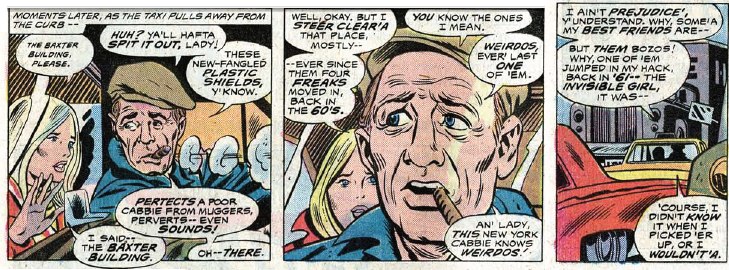
Stretching time is a sign of Franklin's
influence.
Chronologically he is now 7 years old, but he's afraid to grow up,
and is biologically three years old, at least in this reality: in
other realities he grows at the normal rate (see annuals 23
and 1998). By the end of this act, Act 4, the stretching will
reach its limit: FF291 will place Nick Fury's teenage years
in their proper place, the 1930s. True, Nick uses an anti-aging
potion, but he fought with Ben Grimm in WWII, and this was the
closest that the comic could come to hinting that yes, the
original dates were still fixed, even at the end of the 28 year
story. It was still possible to ignore the discrepancy, but only
just. In 291, Byrne says that Sue met Reed when Reed was at
college and Sue was just twelve years old. Being just twelve
allows her to say she was not born in 1936, whereas we know that
Reed and Ben fought in WWII. Conveniently, neither Reed nor Ben
are present in the 1936 story. A couple of years later these
rationalizations no longer work (Ben and Reed would need to be
sixty years old), time will break completely, and the real
world will be replaced completely by the Franklinverse.
The Valentines issue: Johnny and Alicia
This is the issue where Sue's control of the team begins and Johnny
feels happier. It's Valentines' special (see comments by FF 159) and
so the long term future is foreshadowed. Until now Johnny has seen
his romantic life fail completely (and this will continue throughout
act 4). But eventually Alicia will save him. At this point Alicia
has seen her romantic life hit a brick wall. Here Johnny jokes about
dating Alicia: this idea sits in his mind, first as a joke, but the
seed has been sown. Notice how this tiny detail fits perfectly in a
subplot that will not bear fruit for 12 years (our time).
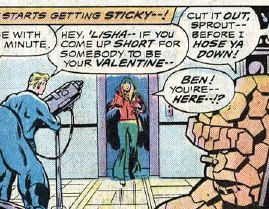
Other points to note
- The doppelgangers motif is very common throughout the FF,
allowing characters to see themselves in new ways.
161
Issue 161: Reed over stretches in every way:
for the first time he feels fear.
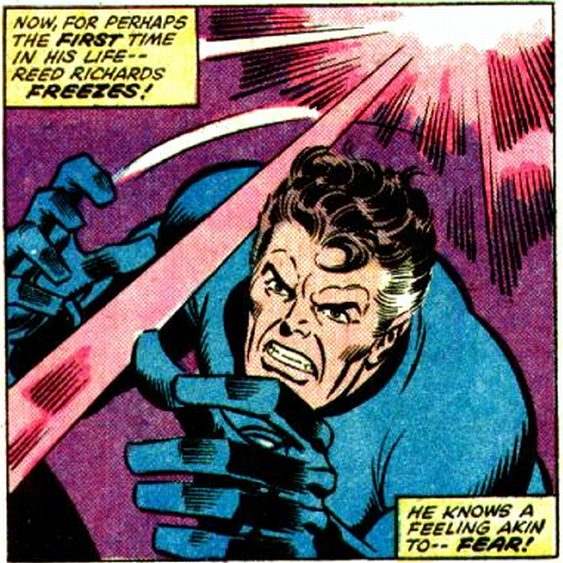
This is Reed's wake up call: the moment when Reed should have seen
what was happening. Never before and never again would so much go
wrong at one time, and he will never again admit his fear and
weakness. From now on it will be bottled up
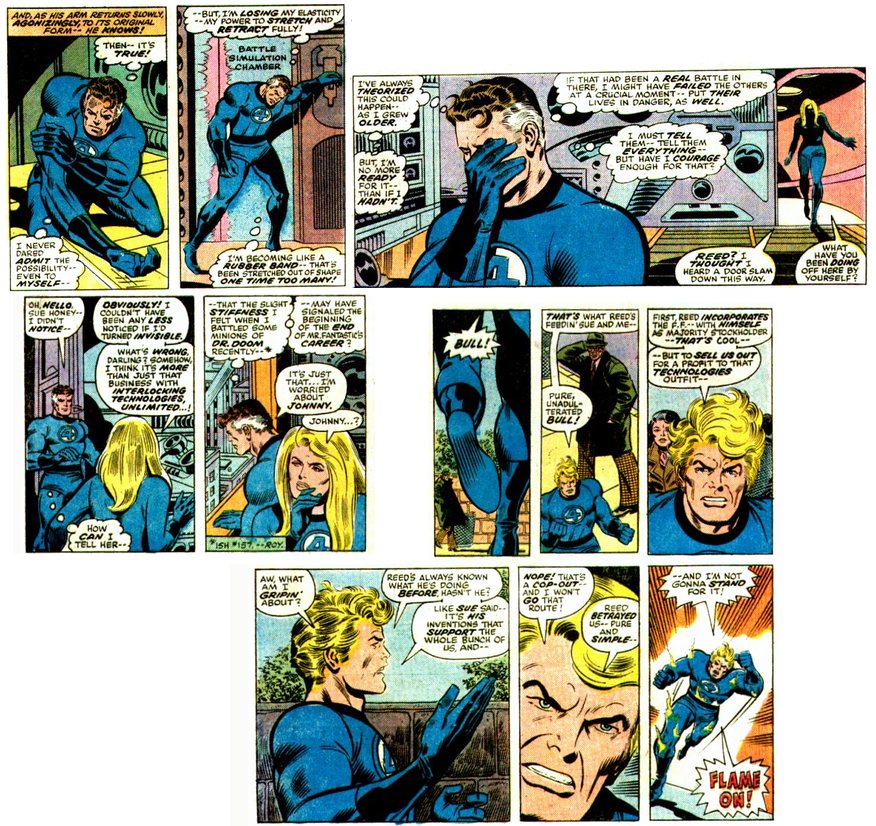
Reed and Johnny find themselves in this arc, but this is the issue
where Reed must face himself - and loses. The remainder of Act 4
shows the resulting despair, but this is the issue where readers
can see it, and Reed cannot.
All because Reed over stretched himself, trying to do it all
himself. He finally realizes that he is acting out of fear, and
putting the others in danger. He knows it in his head, but he
won't change his behavior. He still think everything must depend
on him, and that he must lie to the others because they cannot
handle the truth.
All the world wars
The title "all the world wars" can refer to war with his family:
for the first and only time the team is split into three factions
that fight each other. Not because they are mind controlled or
tricked, but directly because of Reed's poor judgment. This is the
point where Reed finally and completely fails as a leader. In
future issues he pulls back from the brink, but eventually
abandons the team. he then seems to get his strength back, but not because of any change in
attitude. The false dawn of FF200 fails because the
change does not come from inside.
"All the world wars at once" can also refer to Reed's battle with
his health: he loses. Or his battle with financial creditors
(which led to selling the team) - he loses. Or , for the first
time, he is fighting against scientists who are just as moral,
just as clever, and just as important as he is. He has no
experience to cope with this. Whatever it is that Reed wants, he
loses.
For the first time, the hero
acts our of fear
For "perhaps the first time in his life" Reed feels fear. He says
he is losing his ability due to aging. Time is passing (14 years
real time, 11 years as experienced) and Reed can only conceive of
it getting worse. This is a scientist and he fears the future! He
says he must have courage to tell Sue, then does not tell her. He does not have courage, even
though he admits that not telling them will put their lives at
risk. We have never seen inside his head like this before.
Note that this issue is Reed's visibly lowest point: this is
where readers can see everything fail at once. But because Reed
cannot see, he is too stubborn, his emotional lowest point will
not come until later in act 4.
What readers can see, but Reed
cannot:
Readers can see what Reed must do. He must admit he is not "Mr
Fantastic at everything." He should have given Sue more respect, but
instead he lost his perfect marriage (they are back together, but as
we saw in FF157 it is not the same.) He should have made Franklin
his top priority: Franklin is more powerful than them all, but Reed
will not conceive that somebody small and apparently helpless could
be more powerful than himself. Last issue, when deciding to sell the
team against the others' advice (and throughout act 2 when he was
putting the others down and thus weakening the team) he should have
let the others make more decisions, and taken their input seriously.
Like Othello or Lear, Reed refuses to see, he refuses to be humble.
The rest of act 4 shows how he continues to lose everything as a
result. He already lost his perfect marriage, he is losing his
health, he will lose his greatest triumph, lose his home, lose his
best friend (Ben goes to Battleworld), lose his self respect (what
can be more pathetic for a father to promise to protect his son then
his negligence leads to his son repeatedly possessed by demons, just
as Reed is possessed by his inner demon of pride), he will lose
another child, he will lose everything. Note the parallel with Dr
Doom: even the name, Doom. Pride leads to Doom.
Only after losing everything, at the end of act 4, the end of
Byrne's run, the end of issue 295, only then will he finally be
humbled and only then the light of a new dawn will break we can move
on to the triumphant act 5.
Reed's story is symbolized by his chosen name "Mr Fantastic": his
story is a tragedy of pride.
The story title, "all the world wars at
once"
The title alludes to "all the last wars at once" by George Alec
Effinger. Effinger was a rising science fiction star in 1975, and
was experimenting with writing comic books (though not this one).
An Amazon review of "all the last wars at once" summarizes it as
"warring humanity subdivides into all the possible categories
until only individuality is left." The significance of FF161 is
not that words are at war but that the family is at war.
This story of Reed's failing health and financial problems
survival through luck mirrors Effinger's life. From Wikipedia:
"Throughout his life, Effinger suffered from health problems.
These resulted in enormous medical bills which he was unable to
pay, resulting in a declaration of bankruptcy. Because Louisiana's
system of law descends from the Napoleonic Code rather than
English Common Law, the possibility existed that copyrights to
Effinger's works and characters might revert to his creditors, in
this case the hospital. However, no representative of the hospital
showed up at the bankruptcy hearing, and Effinger regained the
rights to all his intellectual property."
Johnny's character development
- Johnny takes responsibility and focuses
on Crystal: he accepts that he blew it with Crystal. So
decides to move on. Eben though he is fated to never have
success with any other girl, or be with another girl for as
long.
- Johnny cracks more jokes. E.g. about Ben and a compass, or egg
beaters and let's get cracking. This probably reflects a change
in his confidence and thought processes.
- Contrast this Johnny with the
later fundamentally light hearted, womanizing, Johnny:
these are completely different characters.
- Johnny works alone: this foreshadows the next generation.
Politics:
- Ben didn't vote for Ford, and has strong feelings against
Rockefeller, even though "Rocky" (Gerald Ford's vice president)
was a moderate republican and would today be to the left of
Barack Obama.
- The other Ben is patriotic, but doesn't like what he's
supporting. See reference to Vietnam in next issue.
- The family is divided in senseless wars. Compare Vietnam and
the divided generations in shaper of worlds story: these
generation based conflicts were not confined to the 1950s.
Other points to note:
- It's not about dinosaurs.
The cover is symbolic, as in issue 1: in fact, Ben could, and
does, fell the animal with a single punch. The significance of
the cover, and the story, is not the dinosaur, but the fact that
Reed cannot or will not help.
- References to "Bigville" or "Cosmopolis" and "back on Earth 1
- oops wrong comic mag" references to DC's fake realism
contrasted with Marvel's real world. Note that by Franklinverse
realism is abandoned (FF322 is the first story with no plausible
deniability)
- Realism: Johnny flaming on creates a pot hole in the road.
This also indicates he's preoccupied: normally he's more
careful.
- Real world history: "what's left of the wilds of long island"
Wikipedia notes that "Owing to economic growth and the
suburbanization after World War II, Nassau [part of long island]
was the fastest growing county in the United States from the
1950s to the 1970s."
- The ice age is destroying cities in the north, just as global
warming destroys cities on the coast
- Lockjaw gnaws on robots for a long time. He lacks dexterous
fingers, but dogs experience much of the world through taste,
spell and texture. He is both converting energy and learning.
- When the dinosaur is first seen, Ben refers to a giant monkey
on the side of the building: this foreshadows events ten issues
later in FF171.
- When Sue says "Thing - look out" this is not a sign of
weakness (Sue never worries about herself). As Ben notes, it's a
sign of sweetness, "always worried about somebody else."
- Ben is reminded of his love for Sue. This helps explain why he
delays marrying Alicia (who, remember, first entered the story
because she looks like Sue).
- The letters page hints at the return of jack Kirby. See the 1968 page for how he was treated and
why it could not bring Marvel back to the classic 1960s era.
- The stories create themselves.
The letters page acknowledges that the stories create
themselves: a reader interprets the hidden meaning of F
157, and asks: "am I just reading meanings that aren't there
into "mere" comic books again?" The response: "You know us,
[name]! If you say
it's there, then it's there!"
- This is (as far as I recall) the first time that Sue is
referred to as "sweet Suzie."
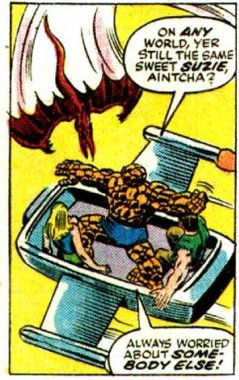
162
Issue 162: the shape of things to come
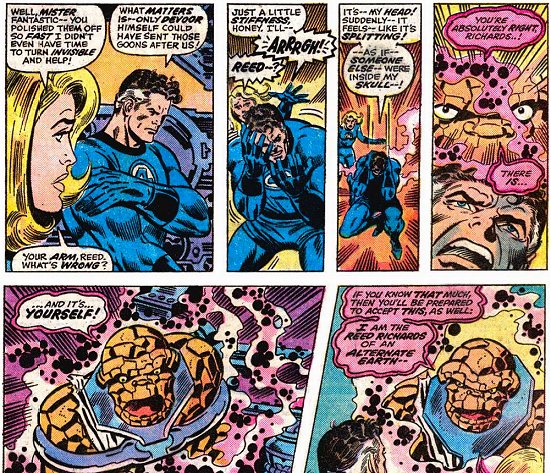
As the title "the shape of things to come" (an H. G. Wells title)
suggests, this foreshadows the future in many ways:
- The Torch as army leader foreshadows his longer, more varied
experience in the Negative Zone in Hickman's run. That in turn
foreshadows Johnny's role as leader of the team in the next generation.
- A Torch dies and comes back, is saved in order to serve an
evil lord of an alien dimension (page 23 and next issue). This
again foreshadows Hickman's run.
- A different dimension's FF, and each one of course sees
themselves as the original. Note page 15: they can combine
strength, suggesting that physical bodies can slip between one
reality and another. Also note page 16, the other reality is
described as only a heartbeat away. This is crucial to the later
Franklinverse, where different
teams slip between realities and do not notice.
- This is a confusing plot that openly states it's confusing:
foreshadowing the entire Franklinverse era, which, like this, is
dominated by friends attacking each other. The 1990s is
dominated by troubles, and the 200s brings Civil War and general
darkness.
- The other Reed finally realizes that his well meaning efforts
are part of the problem, foreshadowing FF295.
- Crazy time slippage (our Earth attacks Earth-A using menaces
from the time machine) again foreshadows the Franklinverse era.
- Parallels between Reed and Doom: if Reed is disfigured, then
like Doom he spends his time on killer robots and also robots
that look like himself (see FF118).
- The nexus equidistant between realities foreshadows the nexus
of realities that can be accessed through the Swamp Thing's
swamp. That nexus plays a major role in creating the "Heroes
Reborn" universe. Next issue we see that this particular nexus
is guarded by a Johnny Storm who has forgotten his old identity,
just as our nexus of realities is guarded by a Ted Sallis who
has forgotten his old identity.
This arc, foreshadowing the biggest story, the Franklinverse and
next generation, beyond, is appropriately placed half way through
the original 231 issue novel.
Hockey and the cold war
The FF is the story of the cold war, so in the early 1970s it had
to include hockey! Note the recent events (from ProIceHockey.about.com):
- 1972: The World Hockey Association begins play, outbidding NHL
teams for several star players. The Summit Series pits the best
Canadian professionals against the best from the Soviet Union
for the first time.
- 1974: The USSR wins the first World Junior Hockey
Championship.
- 1975: Soviet club teams play in North America for the first
time when Central Red Army and Soviet Wings play a series of
exhibition games against NHL teams.
The 3D scopitron
The name "3D Scopitron" is a homage to Stan Lee's fun names for high
tech devices. As for its function, developed by the advanced science
of the 5th Dimension, " I think
Roy was inspired by the Interocitor from 'This Island Earth.'"
(source)
"The Interocitor is an alien
communications device with unusual and strange properties." "The
interocitor, also spelled interositor, is a fictional multi
functional device featured in the original story and 1955 science
fiction film This Island Earth. The device arrives in kit form as
an intelligence test for scientists who might prove helpful to an
alien race." (Wikipedia)
The comics zeitgeist:
Why is this story so
complex?
"You know what Roy's up to
here? It took me three issues to figure it out. This is his
version of 'Crisis on...' Think about it -- multiple Earths, all
similar. Heroes on all three (well, Johnny had to be
transplanted). Universal menace in Arkon stealing energy. And
some serious dimension-hopping to solve it. I suppose when I
look at it through that lens, and accepting it as being part of
DC's heritage of such tales, this is not quite as bad." (source)"
"From 1963 to 1985 the term 'crisis'
was used to describe the annual events in which the Justice
League of America of Earth-One and the Justice Society of
America of Earth-Two met and worked together, usually in an
incident involving one or more of the parallel worlds of the DC
Multiverse. This usage culminated in 1985's year-long Crisis on
Infinite Earths, in which the Multiverse was eliminated." (Wikipedia)
The historical zeitgeist:
- 1970s fear of ice age (opposite of current fear of global
warming)
- 1970s fear of evil corporations buying your soul
- 1970s: atomic power now linked to war, not the space age
(p.27).
The story is ahead of its time: notice the blow back from high
tech drone strikes (p.26) "andrones" designed by "good guys" but
they cause the people with different colored skin to hate you.
Other points to note
- Complexity
This relies on a story from 4 years before. At this stage all
of history matters and all history builds and moves on.
- Gaard
Gaard is clearly influenced by Kirby's Silver Surfer and
Black Racer.
- violence
Reed threatens violence against an unarmed man (p15). Next
issue Sue decides she had better take over sometimes.
- deVoor
devoor is not just aplay on the word "devour", it's German for
"from vors" a place name maning "pre" or "before" (as in the English
"be-fore") - i.e. he comes from before, a hint of dimensional travel.
Devore is a variant of deVere, the mysterious scientist at Project
Pegasus in act 5. The deVere family came to Britain with William the
Conqueror in 1066. They were noted for their zeal in conquering, and
were rewarded with land taken from the Britons.
- Maturity
Johnny is not a shallow youth any more: he's mature enough to lead the 5D world's armies
Religion and armies in the sky
The Fantastic Four is
full of religious parallels (e.g. for the Bible). The appearance
of armies in the sky is a feature of religious history through
history. E.g. regarding the destruction of Jerusalem in AD 70:
"Chariots and troops of
soldiers in their armor were seen running about among the
clouds, and surrounding of cities." (Josephus, Jewish
Wars, VI-V-3).
"In the sky appeared a vision
of armies in conflict, of glittering armor. A sudden lightning
flash from the clouds lit up the Temple. The doors of the holy
place abruptly opened, a superhuman voice was heard to declare
that the gods were leaving it, and in the same instant came the
rushing tumult of their departure. Few people placed a sinister
interpretation upon this. The majority were convinced that the
ancient scriptures of their priests alluded to the present as
the very time when the Orient would triumph and from Judaea
would go forth men destined to rule the world." (Tacitus,
Histories, Book 5, v. 13).
Flatland
This issue has been criticized because of the reliance of people
seeing things that just appear in the sky. Remember that the
technology comes from the fifth dimension. We tend to overlook the
higher dimensional significance because obviously a three
dimensional being (such as Johnny when visiting) only recognizes a
three dimensional subset. But higher dimensions exhibit exactly
this weird behavior when they interact with lower dimensions. To
understand our interaction with higher dimensions, think of how
lower dimensions (two dimensional surfaces or one dimensional
lines) interact with our three dimensions. For more details see Flatland.
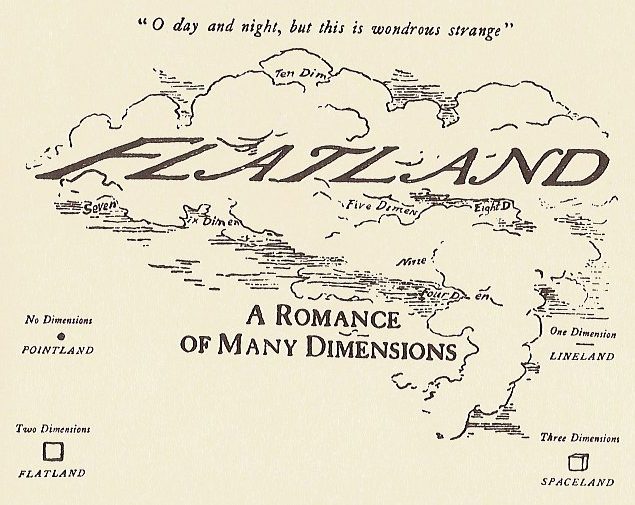
Imagine a human hand passing through the surface of water: if your
experience was two dimensional, if you could experience only the
surface of the water, you would experience the hand as a series of
changing shapes (cross sections of the fingers) that would appear
from nowhere and then merge.
163
Issue 163: Johnny grows up
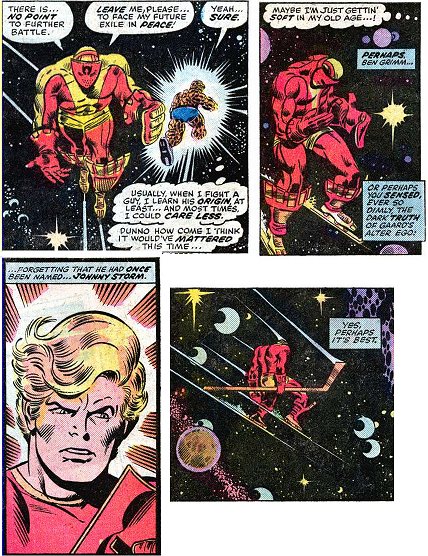
text
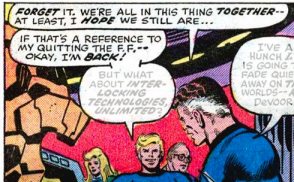
This issue works on so many levels: it's considered one of
goofiest covers ever, yet features a tragedy. As so often we learn
about a character (the frustrations of Johnny Storm) by seeing a
more extreme version in a parallel universe. Some claim that this
was weakened because we did not really know the other Johnny
Storm. But many clues to his identity were given in the run up to
the story:
- In FF118 we see Reed, Sue and Ben (who flies and stretches) but there is
no mention of Johnny. Readers are left to speculate.
- Ben says he needs the surfer. Gaard says he can skim the light
waves - see FF50, this is why Johnny was chosen to visit the
home of Galactus. This reminds us that Johnny is highly skilled
(remember all his early practicing?) yet always has to do what
others say.
- Gaard gives Ben him back his bomb: unconsciously he must want
Ben to succeed. (DeVoor thinks the explanation is that Arkon
likes to see people play and fail, Arkon is described as an
excellent strategist: would he really risk his world in this
way? More likely he lied to DeVoor to reassure him.)
- Gaard says "I should have expected no less" - he knows Ben's
reputation for bravery.
- Ben recognizes his voice.
- Gaard feels he has battled Ben before.
Johnny character
development
At this point in the story Johnny wants to leave. He has grown
up, he wants to make his own decisions. But his experience with
the other Reed makes him realize that Reed is not the enemy: Reed
is just as much trapped as Johnny is. The other Reed naturally
shares Johnny's views deep down, he wants action, not words, but
delayed his decision for too long. After seeing this, Johnny
decides not to quit, for now. Johnny has grown up: he sees things
from Reed's point of view.
That this issue is a major turning point is indicated by the issue
having multiple parts, just as in the earliest issues. At the end
Franklin is said to have grown a little: a sure sign that things are
moving forwards.
The zeitgeist
This is the first issue with a direct reference to Vietnam.
veterans returning from Vietnam to be forgotten (or not returning
at all) was a major theme at the time.
DeVoor
Note how Reed becomes emotional here instead of staying in
control. DeVoor is a a more extreme version of Reed's self doubts:
- A failure in business, on the verge of suicide (compare
FF251).
- A failure at science - all his breakthroughs were from others
(compare FF1 and Reed's reliance on alien tech).
- Pure luck gave him great power.
- His studies of subspace endangered multiple worlds. (Reed
discovered Annihilus through his Negative Zone experiments.
True, Reed was just trying to save his son, but the radiation
poisoning was due to Reed's decision in FF1. Also, Arkon
was just trying to save his own world. Reed accuses deVoor of
selling out for 30 pieces of silver. Yet it was Reed who sold
the FF to deVoor, for money, against the advice of his more
level headed wife and friends.
Part two: Ben and Johnny want out
164
Issue 164: Frankie and Johnny (by Perez!)
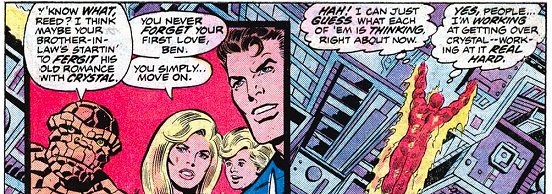
This is a true classic, the first George Perez issue, part of a
superb two parter: bright, upbeat, light and airy art with great
coloring.
This story is an anchor point to the world of the FF: extensive
indoor establishing shots, extensive outdoor establishing shots,
links to decades past (the crusader) and decades future (Frankie,
and Reed's inner struggle). It starts with a strong Jack Kirby
cover and ends with a dramatic final image. Between these we have
fun, romance, danger and trials, it's the Fantastic Four at their
best.
Their happiest point
This is around the half way point of the novel, with the team back
together, most having overcome their relationship problems, and
even Ben is at his most relaxed. This is the beginning of the
false dawn that climaxes in Doom's "final" defeat. We have never
seen the team so happy together, but why?
- Reed has always (mistakenly) seen Sue as the weak link. Now
she seems powerful to him.
- Reed theorized that aging would cause further weakening, so he
is very relieved that Sue got a power boost to more than
compensate. Plus Johnny is younger, and Ben would happily change
back, so the problem is not such a problem.
- Franklin is there, and this is the first time the team has
been able to relax since Sue and Reed got back together.
- Simple literary contrast: we need this light hearted moments
to appreciate the darker times.
The title: the crusader syndrome
The crusader is a mirror of Reed. Reed is on a crusade to fix
everything, through the best of intentions. As with Reed, it is
emotional isolation from others that causes the problems. The
crusader was isolated on another planet, blinded by light. Note
the symbolism: detached Reed is so blinded by his clear righteous
view of some things (technology, dangers) that he does not see the
bigger picture (Family: Sue and Franklin are the real solution to
his problems).
Johnny's turning point continues
Johnny's turning point was FF161, and in 164 he realizes he can't
hide his feelings. At the end he has to get away to think, and to
see what he can still do. (164-165 was originally planned as a
single story for for giant size FF 6.) At the start of the story,
Sue and Ben go along with the buffoonery, happy that Reed is
happy. But Johnny comments. Why? because Johnny the outsider: in
1960s Reed focused more on the bigger threats; Johnny is naturally
a rebel, and will end up
leading the team.
Johnny's transition is symbolized by his new outfit and new
girlfriend, Frankie Raye.
Frankie's fear of flame highlights that Johnny still cannot exist
independently from his flame: that is, independently from his role
in the team. This is despite his several attempts to leave, most
recently in FF160. His early independence, chronicled in
Strange Tales, ended when Sue married and they all took up
residence in the Baxter Building. In a new city he lost touch
with his childhood friends and he was too busy to make new
friends, so lost his independence. Frankie will continue to make
Johnny face himself and his role when she returns in FF240.
Frankie and Johnny
"Frankie and Johnny" (sometimes
spelled "Frankie and Johnnie"; also known as "Frankie and
Albert" or just "Frankie") is a traditional American popular
song. It tells the story of a woman, Frankie, who finds that her
man Johnny was "making love to" another woman and shoots him
dead. Frankie is then arrested; in some versions of the song she
is also executed." -
Wikipedia
The name "Frankie and Johnny" foreshadows Frankie's role in the
wider story. Frankie felt betrayed by Johnny's superhero life: he
loved it more than her. Morally she ends up worse than him,
becomes the herald of Galactus, the world destroyer.
The Frankie and Johnny story also plays on on the subconscious
level. While Frankie believes she opposes super powers she is
actually a superhero herself. And while Johnny believes he is
faithful to Frankie, in his heart he loves Crystal, a fellow super
being. Finally, Frankie believes she is sacrificing herself for a
pure and unselfish principle, but in fact she loves Galactus.
The song (at least in the famous Elvis Presley version) claims to
have no moral, except that "there ain't no good in men" - a moral
undercut by being sung by the ultimate heart-throb, Elvis. The
"ain't no good in men" theme also runs through the FF version:
Frankie's problems are caused by her father, Johnny cannot stop
himself flaming on, Galactus destroys planets, and Frankie must
pay the price. But as in the song, this is undercut by Frankie
being clearly the one to make the choices at every stage (except
as a child), and the male figures were either trying to do good or
were simply innocent forces of nature. Frankie's final role as
guide to Galactus is a nod to her namesake, Franklin, who guides
Galactus. (Galactus's later heralds appear after FF321 and so can
be considered "what ifs").
This story is a many layered thing, and underlines the theme of
this year (FF 164-175): what is a hero?
The zeitgeist:
- What is a hero?
The theme of "what is hero" continues for the 12
month run up to America's bicentennial celebrations in July
1976. This was at a time of national soul searching, after
Vietnam, Watergate, and the oil crisis. never did America ask
the question more pointedly, what is a hero?
- Book titles
Most of the stories in this period, written by Roy Thomas, a
former English teacher, have titles based on popular culture,
usually from the 1960s. "The Crusader Syndrome" probably refers
to "the Paradise Syndrome" and "The Immunity Syndrome," two
episodes of the original Star Trek. One is about Captain Kirk
being declared a God, and the other is an energy draining space
organism. Both apply to this issue..]
- Bankers
The Crusader fights against banks. This reflects the mood that grew in
the 1960s and finally exploded a generation later, in 2008 with the
Occupy movement
- Fashion
This issue has perhaps the most visible example of a dated
panel in all comics: Johnny's unforgettable outfit for his date!
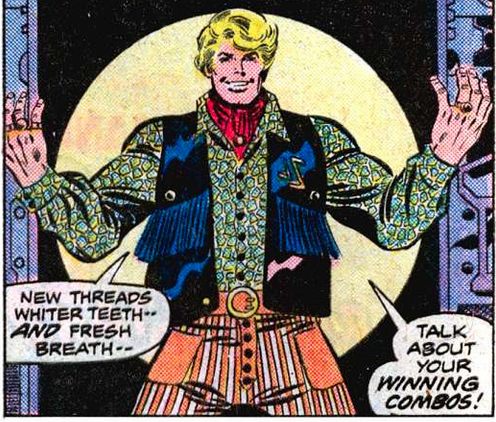
The nature of super powers
This issue contains vital clues to the nature of super powers.
- The Crusader's energy supposedly comes from the sun, as with
Iron Man. but obviously solar energy would not provide enough
energy, but it is needed to unlock cosmic power (the sun
provides full spectrum energy unlike most earthly sources). The
clue is that Crusader gained his power on the outer planets
where the sun is far weaker: plainly it is a catalyst and not
the source of energy itself.
- Johnny's flame runs out soon after being dazzled. Yet he is a
being used to nova flame, and can fly across the ocean when
flying to Crystal. Similarly, Sue create a long distance force
field but cannot normally do this (see link) Possibly due to
Thunder horn, but also saved part of village in Kirby's time. In
highly unusual circumstances super heroes can draw on massively
greater power. Clearly there is a strong psychological element
to the powers. The crusader's mental health issues are a nudge
to make us consider this path.
See super science for more details.
Other points to note:
- A link to the past
Frank(ie) Ray was the pen name of veteran artist Frank
Giacoia, e.g. when inking the Human Torch in Strange Tales 129
and elsewhere.
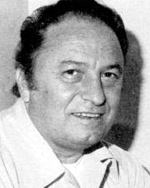
As with the Horton family (of which Frankie is
part), this is a link to the previous era of comics.
- First Kirby!
This is the first Kirby cover since he returned to Marvel after five
years at DC, where he created the New Gods and other Fourth World
stories.
- First Perez!
This is the first George Perez issue - my all time favorite
artist. At first he was introduced in the letters page as Rich
Buckler's long time friend, but he soon became the fans favorite
due to the love and detail he applied to every page, especially
on the team titles that other artists found exhausting. George
is da man! Also known as being one of the nicest guys in comics.
- FF3
Johnny is temporarily dazzled (possibly by the return of Kirby!): this reverses what he did to
the Miracle Man in issues 3 and 139.
- FF19
Blocking the energy source: this solution was used against the
super-skrull, another off-worlder.
- Giant Size FF 6
FF164 and 165 were originally scheduled as Giant Size FF issue
6 but that book was canceled. (See the letters page to 165.
Just as FF158 and 159 were originally to be Giant Size issue 5
but Rich Buckler was unable to meet the deadline so GSFF5 became
a reprint issue.)
165
Issue 165: "For once I don't have all the answers"
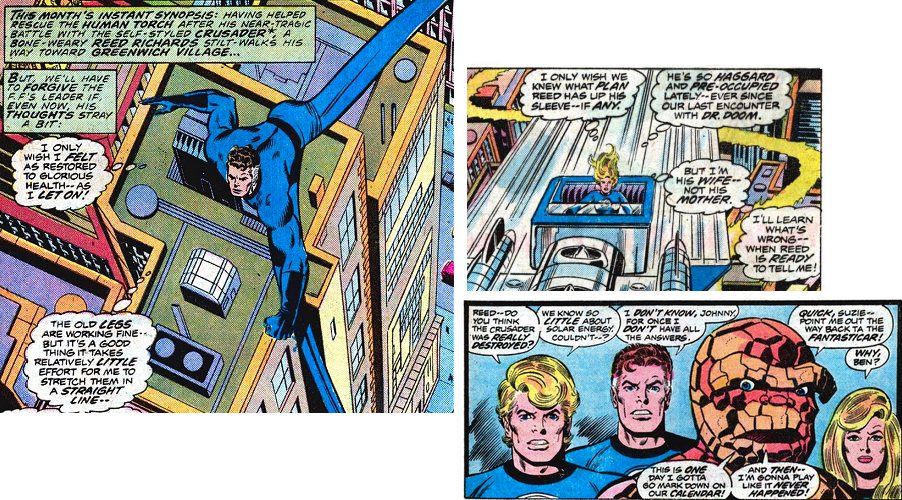
Ben's confidence begins to
return
The story ends with Reed admitting "for once I don't have all the
answers" and Ben says he will will mark it on his calendar. This
issue marks the end to Reed's dominance of Ben. Although Reed
showed his weaker side when he lost Sue, he never admitted
ignorance in humility until now. Ben's confidence now starts to
come back: he gets angry with the bank manager, as in the old
days. We see more of this new confidence in the next two
issues.
But Reed still keeps secrets (his losing power). This is one of
his weaknesses. His humbling will not be complete until act 5.
Reed and the title: the light of
other worlds
Reed's mind is elsewhere, seeing a bigger picture that others do
not see (his intelligence, plus his secret loss of power).
Ironically he cannot see that the light of his life, Sue, is where
he needs to be, back on this world, if he wants to succeed.
Once again the Crusader is a mirror for Reed. We also see another
mirror, Dr Grayson. Grayson, like Reed, built a rocket ship that
endangered innocents. His ship probably using alien
technology, like Reed: a gravity engine is highly advanced,
and the 1950s was a time of many abandoned flying saucers.
Johnny's development
continues
Sue stops herself telling Johny what to do: "he's a man now."
Contrast this with the different,
parallel reality team in Waid's run, where Sue has to tell
the different Johnny what to do because he's so immature.
The zeitgeist
- Note the reference to anti-cigarette commercials. At this
point in the 1970s the danger from cigarettes is becoming
apparent. The FF is ahead of the game as usual: the ads
sis not make use of comics until later (the famous Superman anti
tobacco ads).
- Comet Kahoutek is referenced: it was first sighted 1973, and
was much hyped by the media. The closest approach was New Year
1974. This story was dated December 1975 and the Crusader refers
to the comet as "more than a year ago". This could be a late real time reference,
but Marvel Boy was confused, so could be wrong.
- Reed uses Marvel's 1975 calendar.
- The last panel: "we know so little about solar energy" - solar
energy was a hot topic in the 1970s.
- This is one of a series of story titles based on cultural
references. "The Light of Other Worlds" is based on "the Light
of Other Days," a poem by Sir Thomas Moore, about the sadness at
the loss of the past. It refers here to the tragedy of Marvel
Boy.
Other points to note
- "What's that up there? It ain't a pigeon or a plane" - a
reference to Superman
- The Crusader looks 20, but is well over 30: he blames it on
gravitational space travel. Compare Franklin's
time dilation: another kid with mental health issues.
166
Issue 166: Johnny wants to leave; Sue improves her powers; Ben accepts himself
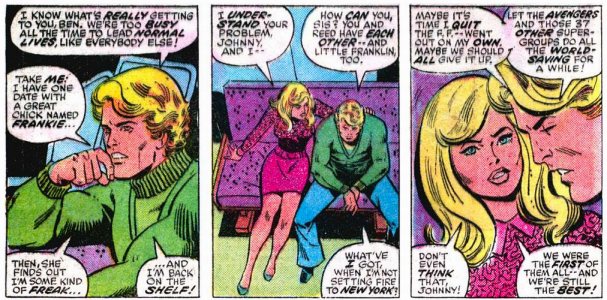
Johny would like to quit. He is the only one of the team one who
enjoys being a super hero, but it's killing his love life. He
needs someone to love who is as powerful and dedicated as he is.
He needs Crystal.
Sue's power
In this issue we see
Sue using her power in novel ways, such as to lower Ben from a
great height. Carol Strickland famously
criticized Sue for not using her force fields to fly, and in
his first solo issue John Byrne had her suddenly think of the
idea. However, she was clearly thinking of field based transport
here.
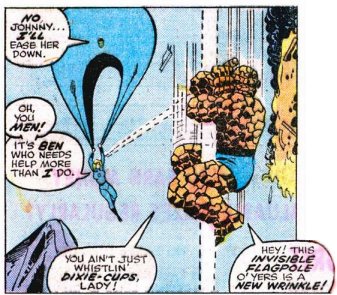
Reed's parachute probably gave her the idea for this, just five
issues later:
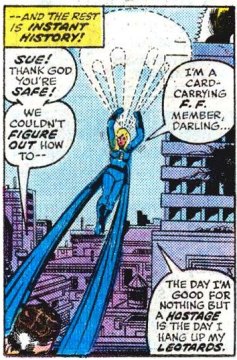
In the next issue we see her using it as a platform for walking
on water, and she says that she was practicing in secret. Then in
171 she uses her power in more complex ways (attacking two
missiles at once). Two issue later (the cover to FF173: Jack Kirby
always has the best ideas) we can see that flight is an obvious
use of her power.
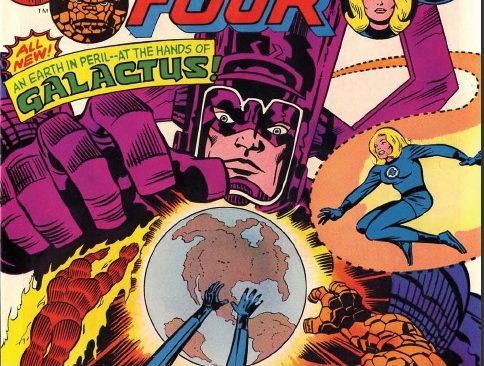
However, Sue has trouble extending a large force field to any
great distance, as we see in FF200.
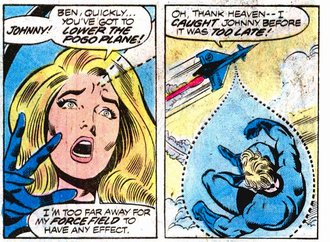
Her powers will increase in FF214 when the Skrull aging ray is
reversed (see FF215) and then force field flight will be possible.
She doesn't have a reason to do it until FF232 though.
Other points to note
- Art
Compare the same penciler under two opposite inkers: Joe
Sinnott (FF164-165) and Vince Colletta (FF166). Sinnott's looks
is synonymous with the FF, a much admired pro. In contrast,
Colletta is widely reviled for his practice of erasing pencil
art to make his job easier (though in this case he has retained
most of Perez' trademark detail, but in a hurried form). Hence the
famous quote from the legendary Gil Kane: Colletta was his
"second favorite inker" - and his first favorite? "anybody
else." But in Colletta's defense, the page rate back then was
terrible, and senior editors loved him because he would always
say "yes" and deliver the job on time, no matter how crazy the
deadline. Colletta was the go-to guy in any crisis, so was
always had work. He was capable of very beautiful art, but
always gave the minimum necessary effort. He saw how Kirby and
other artists gave more than they needed and how they ended up
angry and struggling. Colletta understood the industry, gave it
what it wanted, and was rewarded fairly.
- Cultural references
This is one of a series of story titles based on cultural
references. "If It's Tuesday it Must be The Hulk" is based on
"If It's Tuesday, This Must Be Belgium," a comedy known for its
guest stars and famous sites. This F issue features the Hulk on
a national monument.
- Ben accepts himself
Ben is finally sick of wanting to be like other people. Note the
reference to Elton John's most personal album, where the songs reflect
the challenges of being gay in a world made for straight people. For
more about Ben and queer culture, see the page on the Great American Novel. For more about Ben's sexuality see the notes to FF65-66.
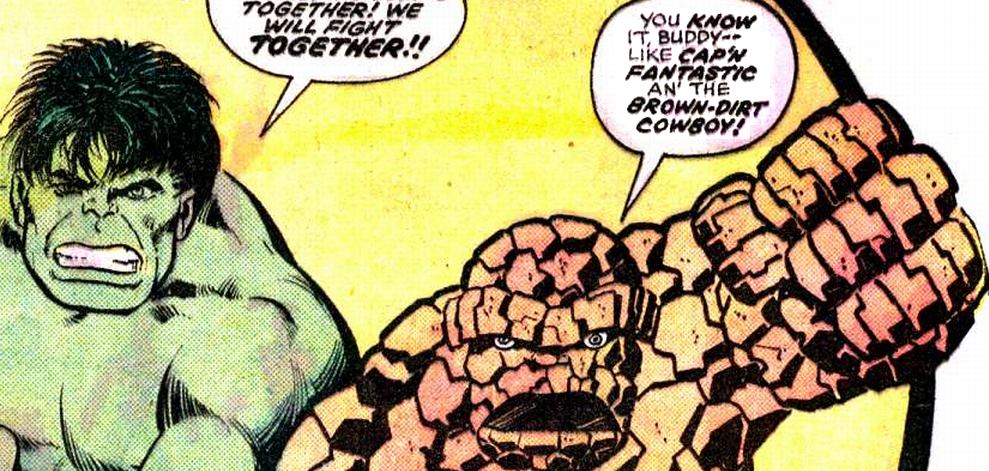
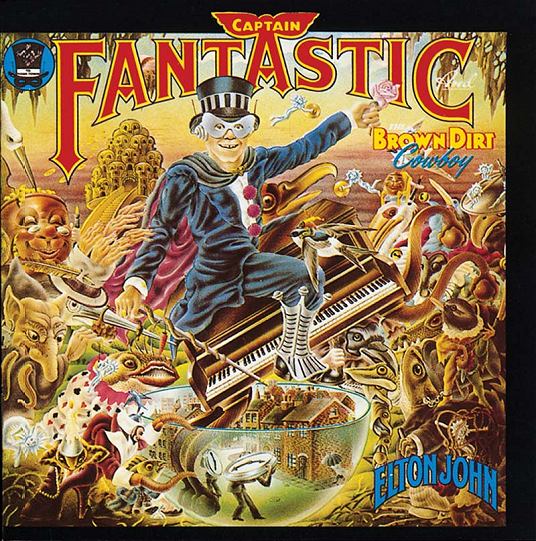
This is Ben's false dawn, just as Reed will have his in FF200. It see to
Ben that he now knows who he is. But will he go far enough and finally
speak to Alicia? Will he really
decide who he is? Note that the main track on "Captain Fantastic" is
"Someone Saved My Life Tonight", about Elton John's decision regarding a
fake marriage. This does not
mean that Ben is gay, but this is the time when he must finally decide,
like Elton John, what he really wants from life.
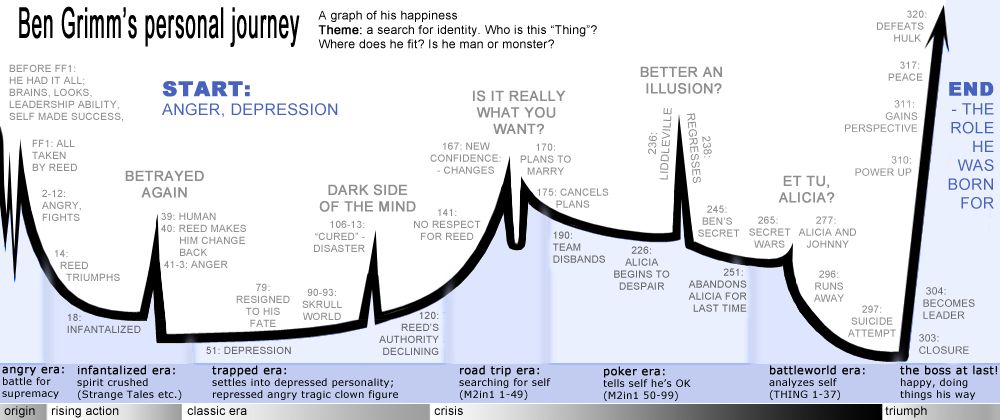
167
Issue 167: Ben gains in confidence
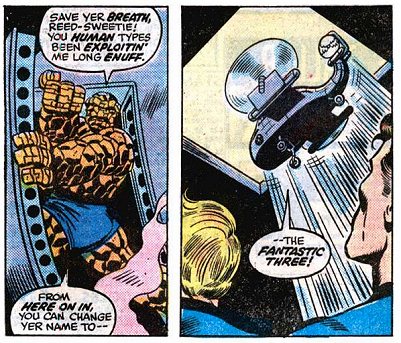
Seeing the Hulk, and how Reed has no sympathy, Ben finally makes
the decision to leave. His respect for Reed took a dive when Sue
left, and took another dive when Reed zapped Franklin, but Reed's
attitude to the Hulk is the last straw.

Note that Sue had to practice her skills in secret. Reed never
encouraged her to use her power in new ways.
Ben's changing is related to
confidence.
Could gamma rays change Ben back to human? It seems impossible to
imagine that Reed had overlooked this. Gamma rays are the obvious
first solution to try, given the similarity between Ben and the
Hulk. In the very early days, the Hulk would use a gamma ray
machine to change in both
directions. Also, when Ben changes back in FF275, Ben
asks if gamma rays can change him back again, and Reed indicates
not. (It is possible that Galactus arranged it that way, but that
possibility was not tested, and it is not even certain that
Galactus did change Ben
back.) Perhaps the gamma rays helped, but there is already a well
established reason for Ben changing (though it will not be
explicitly stated until FF245): Ben's ability to change depends on
his confidence. (So does the Hulk: he changes when passionate
about something: Ben and the Hulk have
basically identical powers, but they appear different
because of their different personalities.) The most obvious
feature in this story Ben's confidence. He's been supremely
confident for some time, and not surprisingly he changes. But that
change knocks his confidence, so he is not able to change back at
will.
For why he changes back, see FF175.
168
Issue 168: America comes of age
Johnny, once a child, grows up and leaves

Finally Johnny sees clearly. The "we need you" excuse will always
be true. it is not enough to keep a man from leaving his parents.
If he had accepted this two years earlier then he could be with
Crystal, and Crystal would still be helping the team, and the team
would be even stronger.
Ben, the ordinary American adult, faces reality
For all these years Ben has wanted to be human. Finally he gets
his wish. And he begins to realize that his real problems are inside.
The problem with being a "thing" was not his skin, it was that he lost
his identity as a football hero and test pilot. The name "thing" is all
about identity.
Ben thought that becoming human would solve his problems, as if he could return to where he left off in 1961. But now
it hits him: he's spent his adult life being a superhero. He
doesn't have a career any more. Alicia would have to support him
with her earnings. Ben is an old fashioned guy, and this is
not an easy concept to accept.
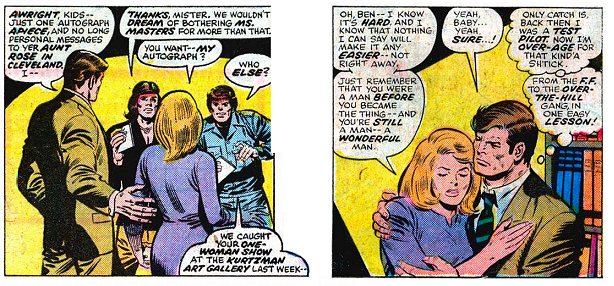
The date: the Bicentennial begins here
This issue is dated March 1976: on sale late December 1975 (see the
cover stamp: newsstand comics like this one often had date stamps from
the distributor).
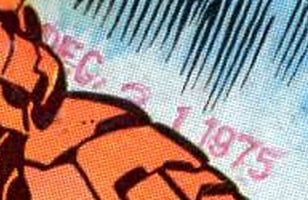
Since the comics were on sale throughout the month, this was the first
issue of the Great American Novel that was on sale in 1976, the
bicentennial celebration. And what an issue!
Where have all the powers gone?
Note the title. And note how Johnny is spiralling aimlessly and now
facing downwards. And note the detail of the regular worker cleaning the
windows: a symbol both of the ordinary man reaching the top heights,
and of seeing more clearly.
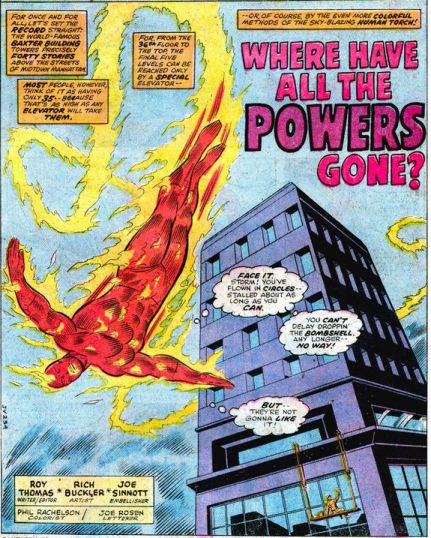
The title, reflecting perhaps the most poignant of all anti-war songs,
is homaged in this, perhaps the most poignant of all anti-force comic
stories.
"Where have all the flowers gone, long time passing?
Where have all the flowers gone, long time ago?
Where have all the flowers gone?
Young girls have picked them everyone.
Oh, when will they ever learn?
Oh, when will they ever learn?
Superheroes are about force. They have physical powers that enable them
to easily defeat any regular mortal. but what good does it do them? Mr
Fantastic has been losing confidence throughout the 1970s, and with it
losing his stretching power. Johnny, the only one to fully embrace
his powers, is so frustrated that he leaves the group. Ben, once the
most powerful being on the planet (in muscular terms), is an ordinary
human again, and finds it isn't what he wanted. And Sue, the one who has
always preferred non-violence, is unable to stop her family from
falling apart.
Where have all the powers gone? The answer of course is that violent
power is not power and never was: it is the illusion of power, because
it creates retaliation, or at least copying. We saw that power is an
illusion in issue 3, the most derided and perhaps the most important of
the early stories. We see it again at the very end, in the overview of cosmic power at the end of annual 23.
As we saw in the commentary to act 1, the overarching theme of thie 27
year story is that "super powers" are no answer, and "soft power" is the
only way.
A parable of America
Ben finally gets everything he wants and realizes that it does not make
him happy, Happiness is not about "getting things". it's a attitude of
mind. This is the late 1970s, when America was at its greatest power and
greatest national health: people have never had it so good, either
before or since: see the notes to issue 200 for details. yet this is the
time when the average American felt things were at their worst: with a
national malaise. That's humans for you.
A parable of equality
America was created on the principle that "all men are created equal".
Ben Grimm is a symbol of blue collar America: he identifies with the
common man. The common man tended to take great pride in equality. he
had to, because he was at the bottom of the social pile, and only by
unionizing could he challenge bosses. But equality is a two edged sword:
do we allow outsiders to be equal? At the time of writing (November
2014) the big news is that Barack Obama is letting more immigrants
settle in America. Many American workers feel that this threatens their
jobs, so they oppose it. Equality only goes so far. The cover to FF 168
illustrates this: Ben Grimm always wanted to be like everyone else, and
now that he is, someone else takes his job.
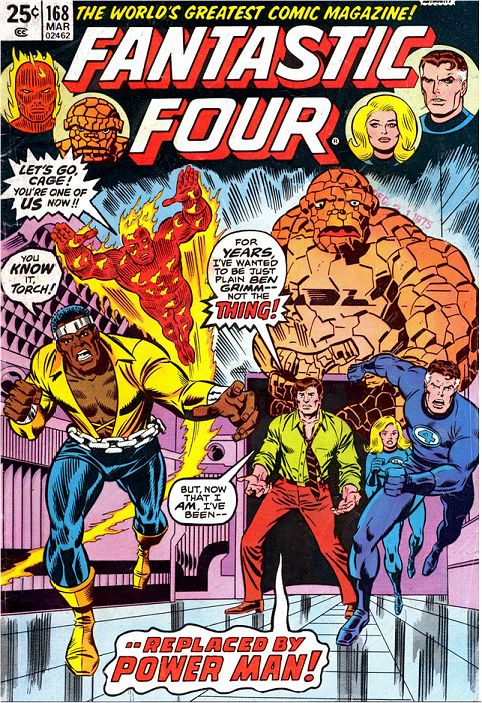
This reflects the times: unemployment first became a major national
issue in the 1970s. (Well the first time since the Great Depression,
obviously: things were worse then, but most people born since then had
not experienced it as a major problem).
A parable of race
Note the presence of Power Man: a black man in a still largely racist
society, Luke Cage shows that other people have it worse, and the real
problem is inequality, the very thing that super powers increase. Also
note that the danger room is a homage to the X-Men, a series about being
a minority, an outsider distrusted by the mainstream.
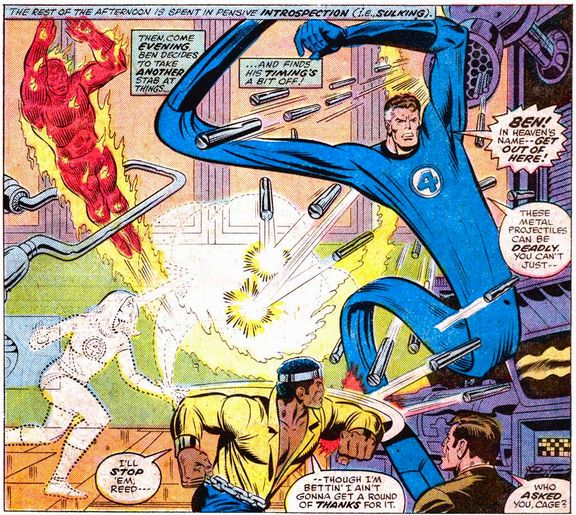
And now Ben Grimm doesn't even fit in here: he is learning what being an outsider is really
like. Also note that in this story Luke defeats the one being even
lower on the
social ladder than he is: an android. And he worries about the cost: the
privileged don't have to constantly worry about money, but people at
the bottom do.More zeitgeist
- Luke Cage reflects the 1970s trend for strong black
characters in movies and on TV. He must have struck a chord: the
Hollywood actor Nicholas Cage took his name from the character.
Note that racial equality is sometimes skin deep: Power Man is
welcomed into the team, but he is not equal with the others, and
will soon be gone.
Other points to note
- Alicia's career
People want Alicia's autograph, not Ben's. Johnny has a similar experience in
FF302:
- Self made?
Ben is not the only one with identity issues. Alicia is a successful artist, but is she really self made?
Critics would say that she gains publicity that other artists
would kill for, simply because she's part of the Fantastic Four
family.But unlike Ben, Alicia accepts her position.
- Cultural references
This is one of a series of story titles based on cultural
references. "Where have all the powers gone" refers to the anti
war song popular in the 1960s, "where have all the flowers
gone?" It suggests deep permanent sadness, not simply a
temporary loss.
- The Baxter Building
The splash page confirms the height of the Baxter Building (40 floors,
contrasting with the Franklinverse's 35 floors). This illustrates how
the Franklinverse is only vaguely aware of the real FF. Page one stated
the building's height very clearly, "once and for all", and modern
readers are completely unaware. For details see the notes to FF 148.
- The window with curtains
This is the first time we've seen a regular window and curtains since
act two. Presumably Reed is making an effort for Sue, who wants him to
focus more on the family.
169
Issue 169: Ben still feels trapped
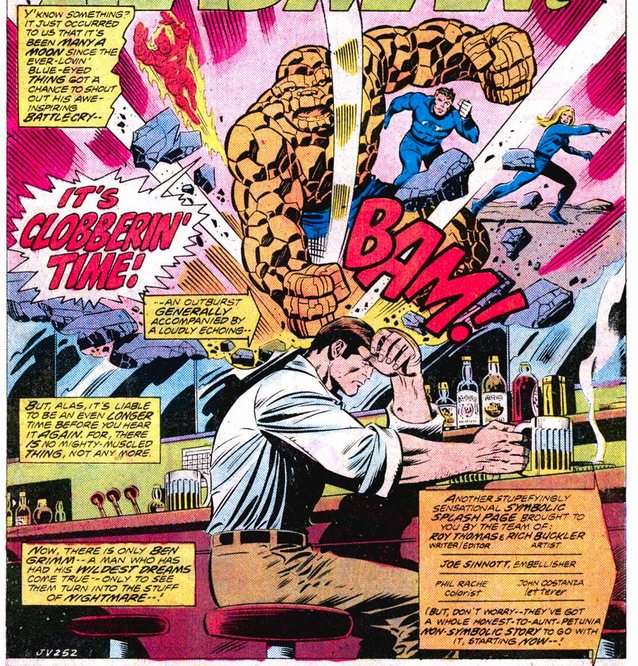
Note the symbolism in this issue: it's as if the Thing is pounding
Ben down. Ben's years of low self esteem are hard to shake. All he
can think of is:
- Ben has no career. No future.
- He no longer has any claim to fame: if he married Alicia then
she would have to support him, a nobody.
- He's easy to replace on the team: the Thing was nothing
special (see FF171). For why he (wrongly) believes he was not
Hulk class, see his own page.
- At the end it appears that Reed has got one of the other
Things from another dimension: Ben is not special or needed in
any way (or so it seems).
- Next issue we see that the other Thing is just a suit that
Reed made. But is this much better? It makes Ben dependent on
Reed's again.
Ben's confidence didn't last long. It will take three more years (their time) before
Ben can finally sort out his real
problems:
- He thinks The Thing he is ugly, but he isn't.
- Reed destroyed his confidence
- He resents Reed and can't see past that.
- he's become psychologically dependent on Alicia, it's
unhealthy, he cant stand that, but can't see a way out
These problems will not be solved until
- Reed is no longer the alpha male in the group (Reed betrays
weakness throughout act 5, and finally leaves)
- Alicia leaves him, forcing him to face his problems alone
- Ben explores his psychological issues (on Battle World), and
finally stops blaming Reed
- Sharon (Ms Marvel) lets him see himself as other see him, and
he can experience real love, free of of all his psychological
baggage
Other points to note:
- This is one of a series of story titles based on cultural
references. "Five Characters In Search of a Madman" is
based on the play "Six Characters in Search of an Author." It's
an absurdist play, again reflecting the loss and questioning
that characterized the 1970s. The original play was written in
the 1920s but revived in the 1960s and three times in the 1970s
(twice on radio, once as a movie in 1976). A Twilight Zone
episode broadcast in late 1961, when the Fantastic Four first
began, was called "Five Characters in Search of an Exit." The
title is appropriate for how Ben feels trapped.
- For parallels with FF69, see comments by FF172: "the 100 issue
cycle".
170
Issue 170: Alicia's strength; Ben's great test
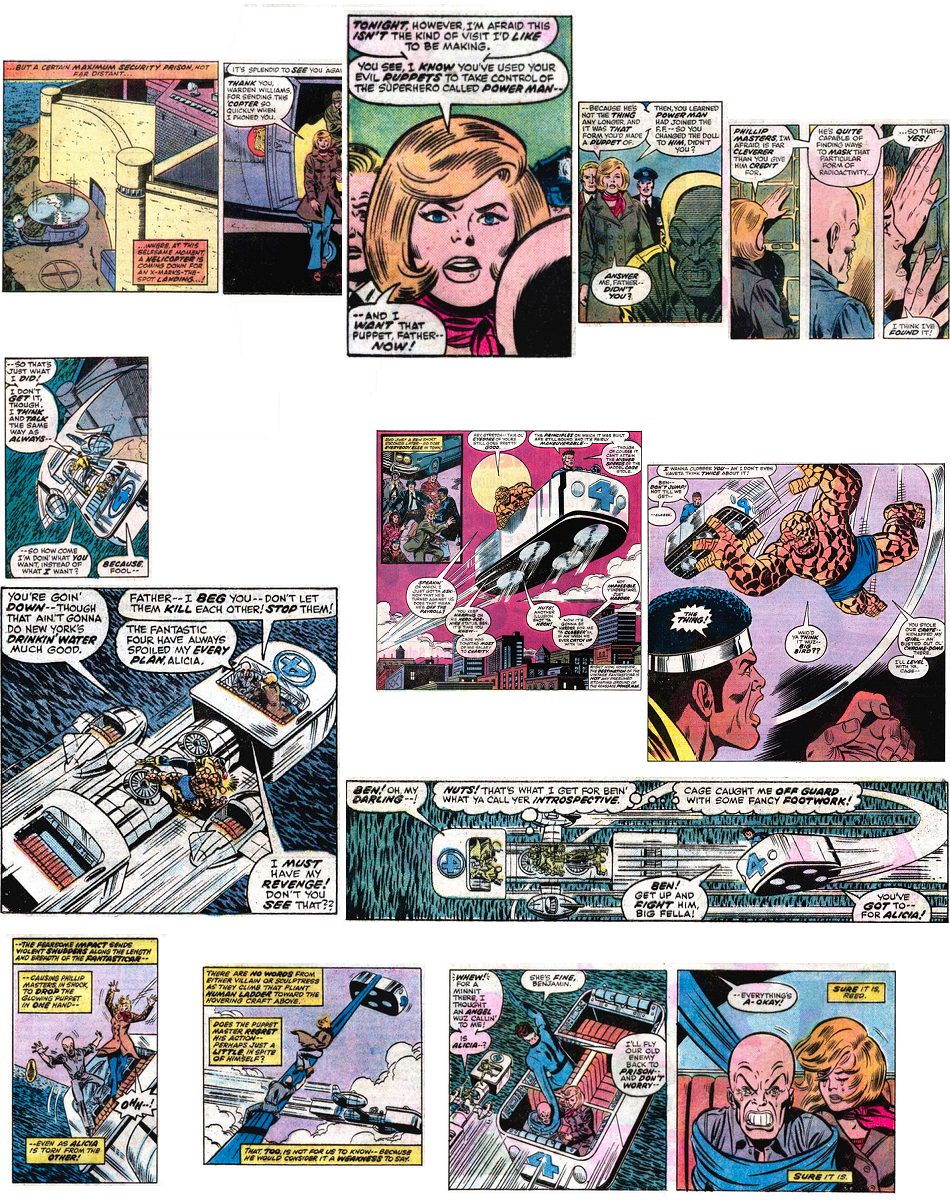
This is Ben's great test. So here we are reminded that Alicia is strong. Buit is Ben? Will he pass the test?
It is easy to
think that Alicia is passive. But she is an artist with an independent
following, she was the one to convert the Silver Surfer and thus
defeat Galactus, and it will be her actions at the end of act 4 that
lead to the solution of all their problems (see FF170). Alicia is the strongest of all.
Alicia has waited years for Ben to be ready to marry. But Ben holds
her back just as Reed holds Ben back.
Note that Ben thinks being able to change skin will solve his
problems. He is not addressing the underlying issue: his false belief that
he is ugly, and his need to blame others.
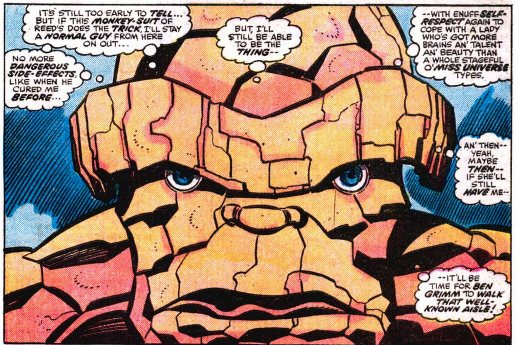
Other points to note
- This is just a beautiful issue. I love the camera angles, the
Perez - Sinnott art, and the bright but not overwhelming
coloring: you can almost feel the wind in your hair and the
sense of vertigo. Exciting stuff!
- This is one of a
series of story titles based on cultural references. FF171 "A
Sky-Full of Fear" is based on the 1968 movie " A Sky Full of
Stars For a Roof": the first spaghetti western to become a black
comedy. It begins with a massacre but in the end nobody gets
what they want. It reflects how in that issue Ben hopes to have
the life he wants, being able to change back and forth as he
wishes, and then marry Alicia. But fate will never allow it.
A11
Annual 11: America's bicentennial: the past
This is the Great American Novel, and annual 11, dated June 1976,
celebrates America's bicentennial. It features Captain America and
WWII, and can be considered a two parter with Giant Size FF2,
which deals with George Washington and the founding of America.
(Ben notes the link, which is confirmed in a footnote: that was
the last time they saw the Watcher, and these are the only times
apart from FF19 that they've traveled in time.)
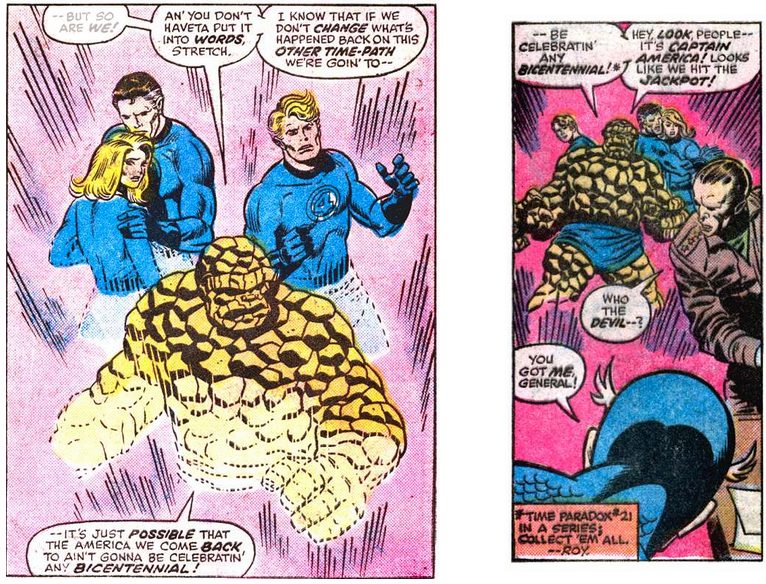
A good starting point for new readers
This special edition is "rife
with American patriotism during the Second World War. I'd
comment that Roy Thomas, through all of his footnotes, has
really woven a true jumping-on story. A new reader would feel
very comfortable with this magazine in hand, as Thomas links
this story to recent and "ancient" FF history, as well as
describing each team member's powers and showing us his/her
personality. I was just really struck by how accessible the
first several pages of this story are. Roy Thomas is insistent
throughout this story that it is indeed 1976 (any doubters,
shame on you -- the splash page reference to Chico and the Man
should have been enough proof)." (source)
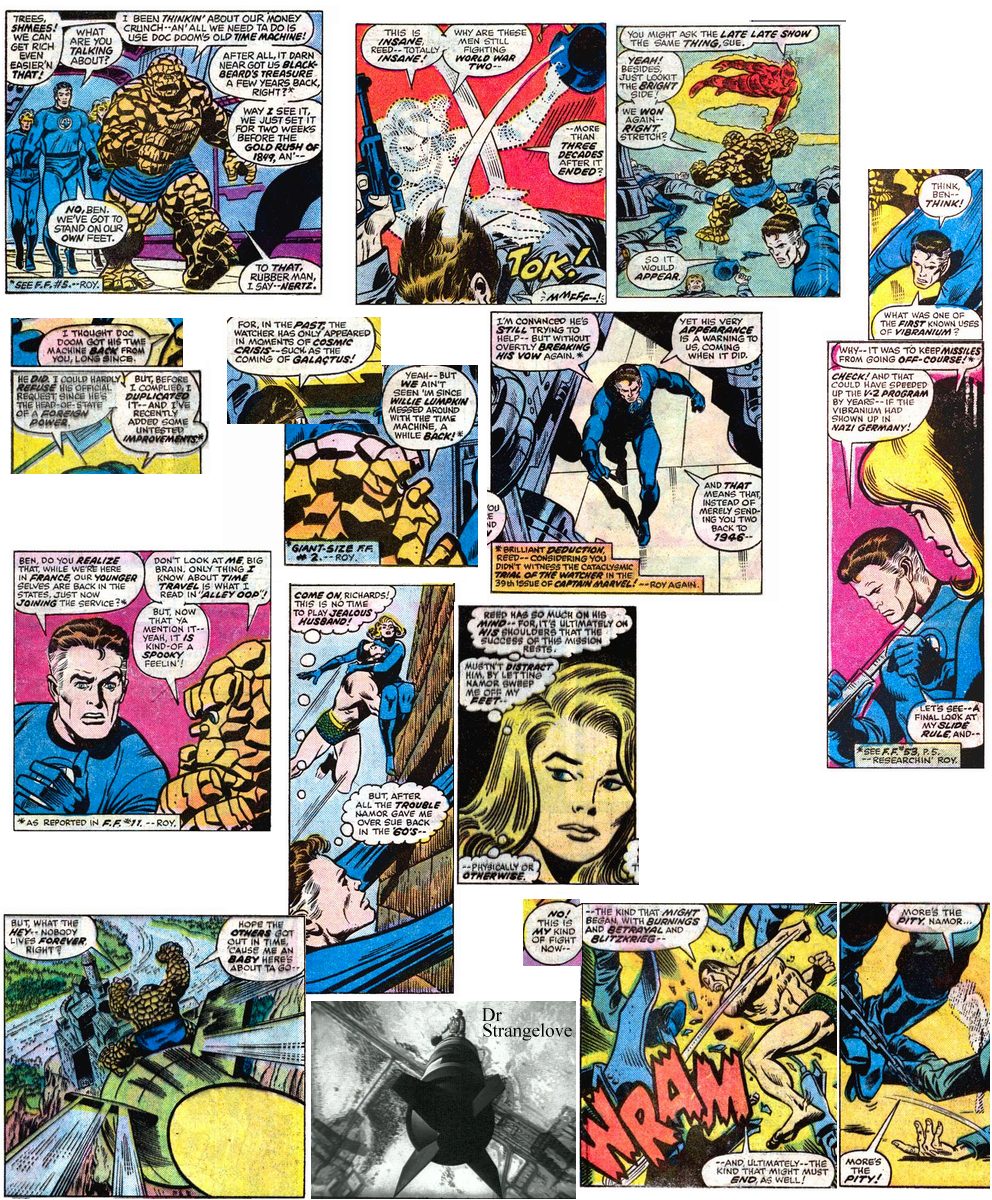
The story begins with a question - why are we still obsessing
over a past military victory? The story ends with a hint that
glorifying war maybe isn't so good: Ben rides a missile, repeating
the famous image from the movie Dr Strangelove.
Other points to note
- Hidden depths
Ben may not appear as angry as in FF171, but he's trying to be
good. Notice the start, where he's frustrated with Reed, and how
he gets too violent with the prisoners. He's angry inside, he's
giving Reed's costume a chance, but his deeper feelings will
come out at the start of FF171.
- Trivia
This 1976 annual, dated June 1976, becomes the first
non-reprint annual of the post Kirby era. By coincidence there are four
"missing" specials (annuals 7-10) and four "extra" specials
(Giant Size 1-4).
- Real time
Ben and Reed are established as being around 52 years old
(though time started to slow down for them in 1968, so they have
probably only aged to their late 40s. They have lived through
one quarter of America's 200 years, and seen great changes. "While in Europe during WWII, Reed
comments to Ben that they enlisted just shortly after 1942. So
let's say they were 20 when they enlisted in 1944 or so. They
would have been born in 1924, which by 1976 would have made
them 52?" (source)
- Reed's emotional distance
The story refers to their financial problems which were the
basis of the problems in FF161. It also refers to Sue and Reed's
continuing marital problems: though Reed is a little humbler
than before he is still distant from Sue, hence it will take her
a while (after FF 178) to realize that Reed is later replaced by
a double.
- Super tech
With the time machine we see another example of Reed's method of invention:
take an existing highly advanced technology and adapt or improve
it. For example, the cross-dimensional TV screen is apparently a 3D scopitron from the fifth
dimension: see the notes to FF162.
- Little details do matter
The use of vibranium in guidance
systems was mentioned when it first appeared, in FF53, as the
footnotes indicate. Roy Thomas was famous for remembering
details like this, as well as for his interest in golden age
characters like the Invaders.
- Non-violence
Sue does not embrace violence as a solution: she considers
Namor's reliance on raw might to be "a pity."
- Other comics
In the first part of this bicentennial double, the George
Washington story in Giant Size FF 2, the Watcher explicitly
broke his vow of non-interference. This time he does not even
speak: Reed infers that something has happened. In the Marvel
Universe, Marvel itself gets its information from the Fantastic
Four plus what they can pick up in newspapers. So the stories in
other comics are largely guesswork. Reed's comment here was
presumably the source for the story in Captain Marvel 39. This story continues in the first annual for Marvel Two In One
(The Thing's own title where he teams up with other heroes.)
- The floor
When Ben stamped on the floor in this annual it broke. (This
was a floor designed to withstand live ammunition explosions!
See Ben's own page for how strong
he can be when angry.) Reed mentioned that he had recently
reinforced the floor. No doubt he reinforced it even further
when it was repaired: in FF184 Ben stamps again, but that time
it merely shakes the entire building. It's this kind of detail
that makes the team seem to occupy physical space, in a physical
world with a building that ages with time, one we can almost
touch: it makes them real.
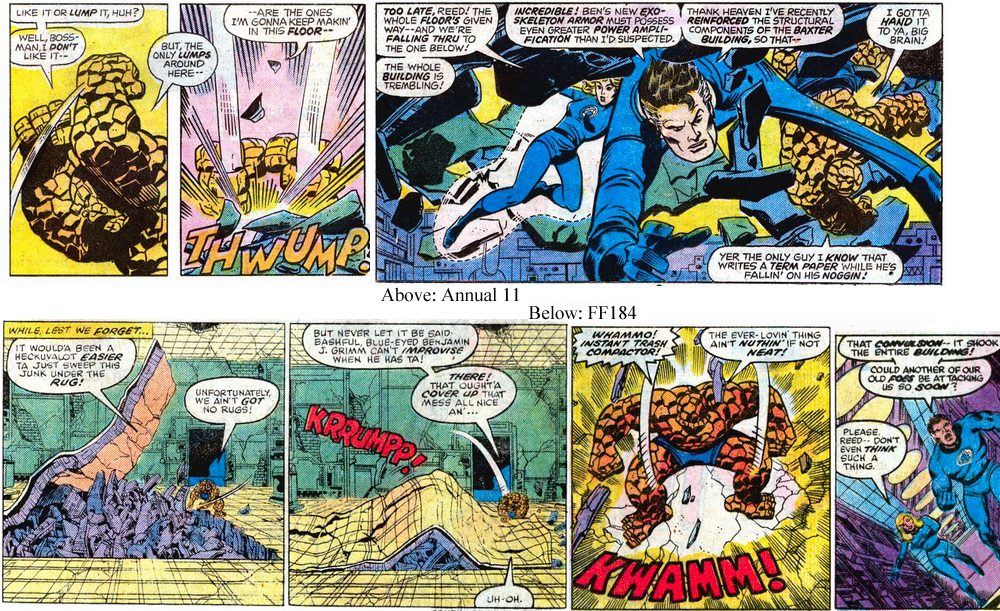
171
Issue 171: my all-time favorite
FF story
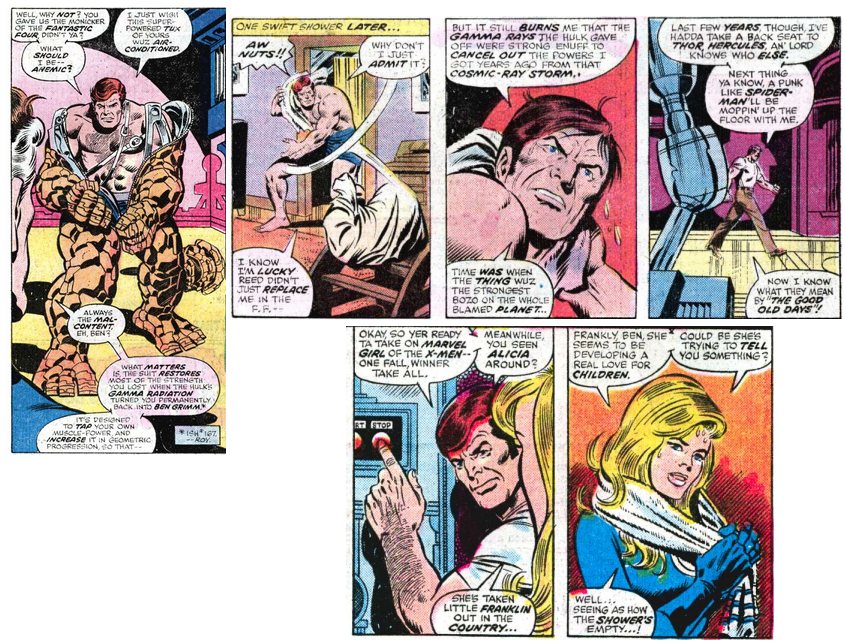
This is the image that made me want to buy every issue of the FF.
It's so real, and you can see the passage of time: a huge, forward
moving story, and with beautiful George Perez art. Plus it's such
a great story! King Kong and so much more!
Note that Ben's insecurity runs deep. Once a person lacks self
esteem it takes a lot to persuade them that yes, they do have self
worth.
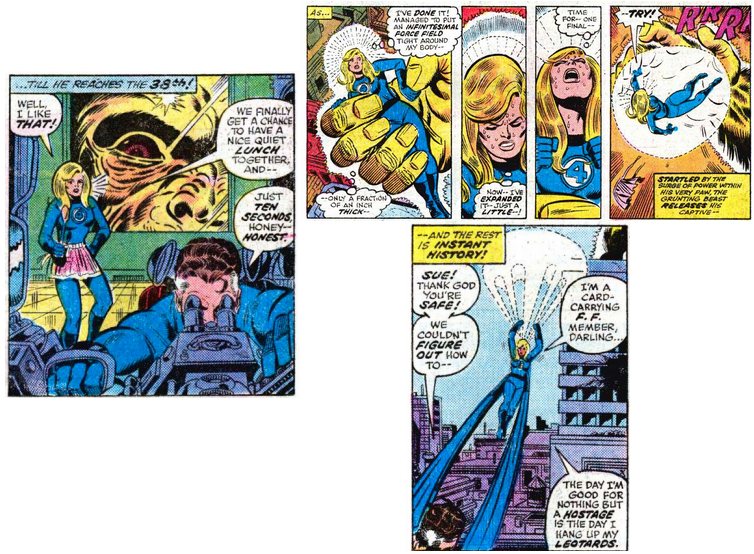
Frankie Rae appears again. Johnny tells her he's considering
leaving the FF (unspoken implication is that he resents Reed's
control of his life, and his immaturity that lost Crystal). This
is part of a years long story. In this issue she starts to
remember strange things that have happened before, a thread that's
picked up again in FF232
The zeitgeist
Ben always represented blue collar America, and this issue shows
his frustration that his physical strength no longer puts him at
the top of the pile. The 1970s was an era where manual labor began
to take a hit. Of course, Ben is not uneducated: he is also a test
pilot. (*The "working class" are often highly skilled, and there
is a strong thread of intellectualism, especially among the
political left. Whereas right wing workers embrace the label "red
neck", socialist workers take pride in discussing philosophy and
enjoying the arts.) But Ben identifies with his street kid roots,
not with Reed's family wealth.
For another example of changing blue collar attitudes (and the
white collar comparison) see the discussion of racism by FF126.
Ben's inner feelings
This period, from FF167 to 175, is central to Ben's story. This is
the only time he was able to return to being Ben Grimm (apart from very
brief periods).

Is Ben ungrateful?
Ben finally has the time to think about it, and realizes this isn't
what he wanted. He knows he's ungrateful, and Reed only wants the best.
But Ben just wants to be his own man: no longer dependent on Reed, and
no longer owing him anything. he just wants to be free. And deep down
he knows it isn't even Reed's fault. Ben has to work this out on his
own. No man wants to feel dependent or beholden against his will to
another man, especially the man who caused his problems. And after his
years of mental pain, with the fate of the world often on his shoulders,
the pressure is almost more than Ben can bare.
When asked if Ben was being ungrateful, Roy Thomas replied "try living in his shows (or overgrown feet) for a few years and see what it does to you." (In Back Issue 74)
The cultural zeitgeist: the 1976
King Kong movie
- "Roy Thomas has mentioned in
interviews that his FF runs were subject to meddling by Marvel
higher-ups; I suggest that the "King Kong" sequences were
demanded of Roy in order to cash in on the 1976 remake."
(source)
- The other King Kong themed issue was FF69. It covered Ben's
inner conflict that would return exactly 100 issue slater in
FF169. This arc focuses on "this man this monster" Ben Grimm and
his attempts, like King Kong, search to fit into the world (see
commentary on FF172). The "golden gorilla" is a mirror for the
"orange teddy bear" Ben: seen as a monster when he is not;
turned into a monster by his best friend (as explained next
issue)
- This is one of a series of story titles based on cultural
references. "Death is a Golden Gorilla" is based on "Death is a
Woman," (In America, "Love is a Woman"), a stylish 1966 British
mystery thriller. The fun of chasing a golden gorilla marks a
change of pace from the sadness of the previous issues.
Criticisms
- The apron: Some people think this shows Sue as low status.
Actually it shows the opposite:
- Apron strings "indicate
complete control or dominance: a grown man still tied to his
mother's apron strings." (- thefreedictionary.com)
Reed is acting like a child, playing with his toys and whining
that he wants "just ten seconds" more.
- Making dinner shows her wisdom: lunch is when people get
together to talk. Reeds great weakness is that he does not
listen to others. Sue knows that five minutes listening
to others will teach him more than he could learn from the
microscope.
- The image shows how Reed is missing the big picture: he's
studying tiny things in a microscope while a giant gorilla is
right behind him!
- Reed is a complete, balanced person. Earlier she was shown
defeating explosive missiles. Later she is shown chastising
Reed for him suggesting she needs rescuing. Sue, unlike Reed,
is a rounded individual. To say she must only defeat missiles is
just as bad as saying she should only cook food.
A personal note: FF171 is the issue that made me an FF fan, and is
still my favorite
Fantastic Four 171 changed my life. I must have been around 13
years old (I read it in 1981, in a reprint). People say that the
golden age of science fiction is whatever you read at age 13,
because it seems the best thing ever. And for me it was FF171.
This is the issue where Ben wears a Thing suit, and he talks about
the past, and how life has changed. It is very obvious that the
experience has changed him as a person: he started as angry (back
in issue 1) then progressed to sort of accepting his problems, but
now he had got to a point where he could not accept it any more,
he wanted to move on. He seemed so real! I was hooked! He seemed
like a real person, with a real past! In the same issue we see Sue
at her greatest: confident, beautiful, developing her powers on
her own, looking so strong and so mature. At around this time (in
another issue) we see Johnny and Ben as adults, talking about old
times. It was really powerful to me, how this was a grand, epic,
long term story.
Living in Britain made a big difference. The FF had been reprinted
from the start (in 1972). Our comics are weekly, so we had almost
caught up with America in 1981. I bought most of the comics at
jumble sales (rummage sales). Then Marvel UK began a series of
pocket books that reprinted the classic Lee-Kirby issues again,
beginning at the wedding of Sue and Reed. So I was reading the mid
1960s stories and the late 1970s stories side by side. I could see
the big events, how they grew older, the marriage, how themes
emerged and developed over decades.
I should also mention that the first American comics I ever read,
as a young child, included a reprint of FF issue 7, the Planet X
story. It was in a big hard cover book of some of the best Marvel
stories ever written, and it affected me deeply. So at the age of
13, when my ideas of what a comic SHOULD be were being formed, I
could very clearly see how time passed over the years, and how it
changed the team. And it changed them for the better: FF 171 was
drawn by George Perez (except for pages 1-3 and those were good
too). It was beautiful. Everything was moving forwards, getting
better. These four people felt like real people, in the real world
(but as exciting as the real world could possibly be). I loved it!
At that point, reading FF 171, I decided that I had to have every
single issue of the Fantastic Four. I was a fan for life. I never
cared for Spider-man - the early Ditko stories made sense, but
after that he never grew up,so he was not like a real person to
me. The same goes for other Marvel comics. They never grew up or
learned, so they were not real. Why should I care for the current
stories if the previous stories made no difference to anything?
So I subscribed to the new FF comics. John Byrne had just started.
I wanted to see what happened next!!!! I so looked forward to my
first new FF comic (it was FF 151). Was Ben cured forever? (He
should have been!) Did Johnny finally marry Crystal? I wanted to
see Franklin as a teenager, exploring his powers and having
teenage fun! I wanted to see Sue expand her role as a mother
figure for the whole Marvel Universe, as the sensible balance to
all the worried and stressed female characters who were trapped as
sex objects (I was very religious as a child - I still am - so
Sue's confidence and style and wisdom and love impressed me
deeply). I could see how much the team had progressed from the
1960s to the 1970s, so expected a similar progression to the
1980s. I imagined Reed as the head of a global organization, I
wondered how the Inhumans might become a secret part of all world
governments... I expected to be surprised and pleased. Naively I
thought the improvement from Kirby to Perez would result in even
better art (at the time I did not appreciate Kirby's art as much
as I do now).
So when I read Byrne's stuff I felt cheated. Not only were the
stories small (my first stories were the negative zone stories
that had no obvious connection to anything) but it was not the
same family, to me.
Reed became weedier and introverted.
Sue was very different - to me she seemed weaker, less self
assured.
Johnny looked younger, and didn't have the inner depths - it's
hard to explain, but I always saw him like me, as a frustrated
observer of life: e.g. seeing Crustal leave him, seeing his family
die, being trapped in the child role of the group, and not being
able to do anything about it. This produced a depth of character
and a personality style that just seemed to be entirely missing in
Byrne's run.
As for Ben, he seemed to once again accept his life, and didn't do
much of anything.
When Johnny got together with Alicia (and let's not talk about
that!) Ben's reaction was not Ben, it was how JOHNNY would have
reacted: he exploded, then meekly accepted it. This was Johnny's
classic style, with Crystal, the aging ray, etc. The Ben I knew
would have been the opposite: he would have had the maturity to
not react strongly at first, but it would have led to powerful
determination and real decisions. Instead we got him moping around
feeling sorry for himself. All of this was such a reversal of
characters, they had forgotten everything that made them who they
were. These were different characters, younger characters, with
completely different personalities, stuck in a twisted imitation
of the past (the flying bathtub and skinnier bodies , etc., were
clearly meant to be like the early stories, but they were NOTHING
LIKE the early stories).
And yet Byrne put so much into each issue that they were still
good comics. They were enjoyable to read. And if I was not so
concerned with them as real people then I am sure I would have
embraced the new team, because they were well written. But they
were not the big, grand, deep team I was addicted to. They were
something temporary. They were more like the X-Men, a team I had
never cared for (whenever I read the X-Men I just want to tell
them to "grow up!")
I did not want to abandon the FF. I did not want to accept, as
some do, that they really ended back in the 1970s. So I tried to
reinterpret the stories in a way that would fit with what went
before. And that is how I came up with my theory that issues 1 to
322 form a single complete story, and they only acted out of
character in Byrne's run because they were in crisis and would not
admit it to themselves.
And that is how I started to see the FF as a single gigantic
story. Thanks for asking!
172
Issue 172: cover dated July 1976
America's bicentennial, the hopes and dreams
This issue is a whirlwind of ideas: so many colors that they
easily blur into a nondescript gray. I will try to point out the
main themes and why this issue is so important.
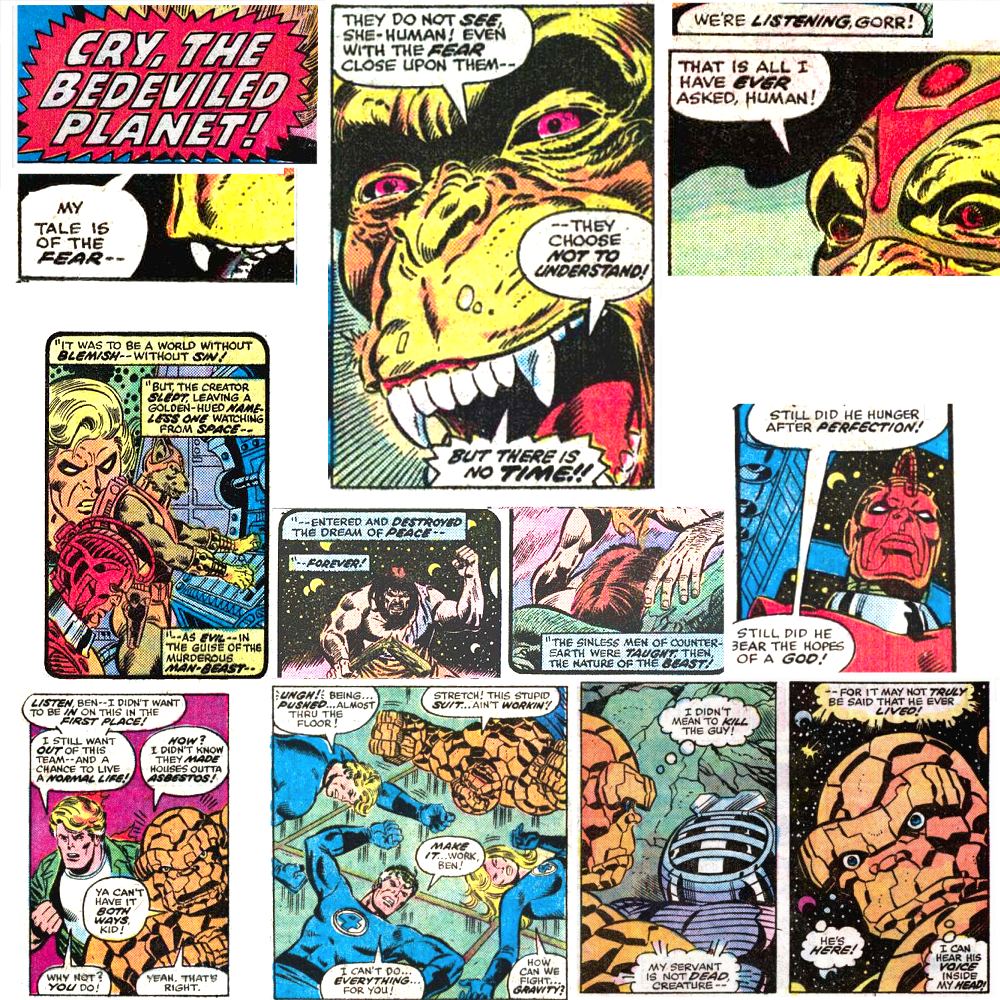
The date
The Fantastic Four is the Great American Novel, and 1976 was
America's bicentennial. July 1776 was the declaration of
independence, and July 1976 was the 200 year anniversary, a time
to look backward on the past and reflect on the future. The
Fantastic Four released two issues to represent July: annual 11
was released in the summer, but ass an annual it was not strongly
tied to a particular month. FF172 was actually cover dated July
1976. Annual 111 (and its companion, Ben's title, Marvel Two In
One) covered the historical events of those 200 years, and FFD172
covers the ideals of the founding fathers: how do you create an
ideal society?
The New World
America is often called the New World, so this issue is about the
founding of an actual new world: a newly discovered planet, hidden
from the old world until now. Of course, like America when
Columbus arrived, it already has inhabitants! But in order to pack
the story into just a few pages, these existing inhabitants are
metaphors for the founding fathers, the common people, and the
concepts of good and evil.
Did not intend to set out and find a new world, just as Columbus
did not (he thought he was going to India). Columbus never
realised he had found a new world, just as most readers never
realise the depth in FF172. Tricked onto the ship, just as
Columbus;' men were tricked (he famously told them it would be a
short journey and that he could see land when he could not).
The golden age and great fear
Fear of the future is a recurring theme in this issue: the golden
gorilla repeatedly refers to the coming of Galactus as "the great
fear". Galactus is a cosmic test of whether people are strong
enough to face the future (See FF262). He is Franklin's
herald, representing Franklin's own loneliness and fear of
the future. For why Galactus appears right now (his
appearances follow a pattern), see the discussion by FF74.
Fear versus the golden age is the overriding theme of America's
bicentennial: in 1976 America was aware of decline. The space race
was over, the nation had just endured Vietnam and a disgraced
president, and was aware of sexism and environmental damage. It
looked back to a golden age (that Ronald Reagen would soon believe
he was recovering). The golden gorilla can represent a more
primitive golden age somewhere out there, the great fear can
represent awareness of all America;'s weakness and troubles, and
the greatest question of all: was this still "the home of the
brave"?
"Cry the beloved country"
The cover title, "Cry the bedeviled planet", is based on "Cry the
Beloved Country", the classic novel by Alan Paton. It is set in
South Africa, as it lost its way and declined toward apartheid. It
is set around the story of a man searching for his son and seeing
the moral confusion around him. Its message is summed up by this
passage:
"Cry, the beloved country, for the unborn child that is the
inheritor of our fear. Let him not love the earth too deeply. Let
him not laugh too gladly when the water runs through his fingers,
nor stand too silent when the setting sun makes red the veld with
fire. Let him not be too moved when the birds of his land are
singing, nor give too much of his heart to a mountain or a valley.
For fear will rob him of all if he gives too much."
It sums up the feelings in America in 1976: they thought they
were a great nation, but now they wonder if sexism and racism and
corruption mean their future is bleak? "Cry the bedeviled planet"
refers directly to counter earth, an alternative version of our
own planet, but of course refers really to our own world in 1976.
This is one of a series of story titles based on cultural
references. "Death is a Golden Gorilla" is based on "Death is a
Woman," (In America, "Love is a Woman"), a stylish 1966 British
mystery thriller. The fun of chasing a golden gorilla marks a
change of pace from the sadness of the previous issues.
Adam Warlock
This issue reveals what happened to "Him", the being created by
scientists to be the perfect man (FF67). He was the next stage of
mankind's evolution. This great experiment can be seen as a
metaphor for America, a country designed to exalt the common man
and show what nations can achieve.
We learn in this issue that "Him" became Adam Warlock, a messiah
over his own world, created this time not by a team of scientists
but he High Evolutionary. Warlock was Jim Starlin's masterpiece
(literally: a "master piece" is the piece of work a craftsman
produces, usually after finishing his apprenticeship, to prove he
is now a master of his art form). Warlock's messiah role allowed
Starlin to explore philosophical and religious issues with the
creation of a new world. Those issues are quickly summarised here
in FF172. Warlock was published in his own title, beginning in
April 1972, just as Stan Lee was finishing his Fantastic Four run,
with his story of the confused Galactus (before his final story
about being misunderstood): see commentary to FF122-3.
Adam Warlock's title continued on and off until April 1976. That
is, his title covers the time between the mind expanding creative
era of Lee and Kirby and the "quo vadis?" (where now?) uncertain
era of 1976. The FF title followed Reed's decline, while the Adam
Warlock title continued the ascent into infinite possibilities.
Now in FF172 the idealism and fear concepts reunite again.
Science and religion
This issue is full of Christian allusions: the high evolutionary
as the creator, his perfect world as Eden, the man beast bringing
original sin, and so on. In 1976 the big question was, will
America remain religious or become a secular society? This is
symbolised in the Great American Novel as a battle between
evolution and the old god who was here at the Big Bang. See more
details see the commentary to FF175.
The body as a shell
With such great questions at stake, this issue has the motif of
the body as a mere shell. It does not matter if the body is ugly
or weak, or even if it dies in the service of a higher cause (the
family or nation): the spirit is what matters.
Ben is reliant on his exoskeleton, and is in the middle of
questioning who is the real Ben Grimm: the Thing, or the man? He
then battles an empty shell: the destroyer, merely a casing
animated with a tiny spark of Galactus' own life force. Note the
names: "The Thing" (an indeterminate name, a man dominated by the
question of who he is), versus "The Destroyer" - a metaphor for
mankind facing the empty void and deciding who he must be. The
emptiness is emphasised by Galactus' great loneliness.
Ben's test
In this issue Ben is tested by the herald of Galactus, just as
Reed was tested by the earlier herald in FF72, exactly one hundred
issues earlier (see commentary). In both cases Reed and Ben do
what they think is right, but they fail to be true to their
destiny, and fail the test. There are several indications that he
failed. Here are just two:
On the flight there he feels heavy, unable to move, just as on
the original flight in FF1. Reed is impatient: he tells Ben he can
find the extra strength, but Ben fails to do so. This illustrates
both of their weaknesses: Reed's feeling that others do not try
like he does, and Ben's self doubt.
In fighting The Destroyer he unconsciously holds back, because he
wrongly thinks the machine is alive (see "I didn't mean to kill the
guy"). See "how strong is the Thing"
for how this fear causes Ben to routinely act as well below his
potential. Ben lacked the insight to understand that the shell did
not matter, only the spirit mattered. That is the story of Ben's
life.
In the next issue Ben is judged and the sentence carried our: he
must return to his endless struggle until he is again ready to
know himself. (We do not see the result of the sentence until
FF275, just before he again crashes to earth)
Will they listen? Will they see?
The great test is summed up by the golden gorilla: will the
people listen? Will they see? Sue always sees clearly. But will
Reed? Will Ben? Will America?
The 100 issue cycle
This anniversary issue is also an internal anniversary. Ben and
Reed's previous tests were in FF69 and FF72. They fail those
tests. Their new tests are now, in FF169 and 172. Again they fail.
In FF269 and FF272 they are again tested: Ben is finding himself
on Battleworld (while in 269 Reed is facing a Galactus-like shell
who looks like The Destroyer (FF269-270), before reconnecting with
his parents (FF271-272), the first step in seeing himself as
others see him, and thence reconnecting with his family.
100 issues later they have resolved their problems, and the comic
then follows a dream team who endlessly
repeat variations on the the old stories: in FF369-372 it is Reed,
not Ben, who is away finding himself, and it is Sue and Ben who
face questions of split identity: Sue merges with Malice, and Ben
now in human form) is tormented by seeing his rocky form in the
mirror. For another example of Franklin's curse, to endlessly
repeat the past, see how Franklin's herald, Galactus, punishes the
Sphinx in FF213. For the general theme of not facing the unknown
see the page on Franklin.
Character development: a snapshot
This issue provides a nice summary of the status quo before Reed
fails (FF172-175), becomes a liability (FF177-188) and leaves
(FF189):
- Johnny still wants out
- Ben still isn't happy,
- Reed's method is to want to control everything. He still
hasn't learned humility: note his impatience with Ben in ther star ship,
and the comment just before that from Johnny.
- Sue's method is to listen and see the other person's point of
view. Sue is right more often than Reed. Reed is smarter around
narrow technical issues, but Sue is more likely to see the
bigger picture.
173
Issue 173: Reed will not confide in Sue
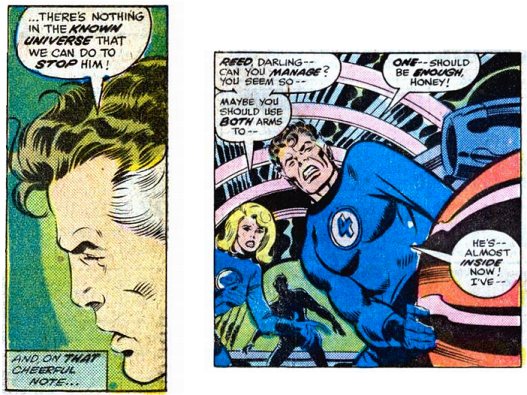
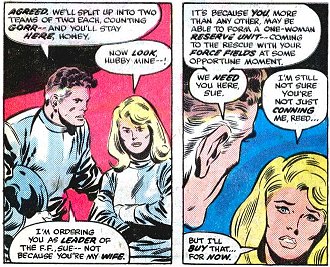
Reed won't tell Sue about his loss of stretching power, even
though he might endanger the team. he's also defeatist:
saying there is nothing they can do. And once again he's ordering
Sue to stay behind. It's like FF127 and FF159 again, but Sue is
learning to adapt: instead of arguing she does what he says but in
a way that she ends up saving the day. Sue wins despite Reed's
narrow mind: the idea that she must stay behind "just in case" is
weak.
Other points to note
- It's ironic: Reed's great mind cannot stretch around the idea
that Sue might be as clever and useful as he is, but in a
different way.
- Reed's rigidity in his body reflects the rigidity in his mind.
- Two of the worlds parallel FF90-93: Torgo was in the Skrull
arena. and we have another world that's themed (this time, to
fairy tales)
- Note the courage and love of the High Evolutionary. He cares
so much for his planet that he will do anything to defend it.
Contrast this with the next Galactus story in FF212-213: a
similar battle of giants, but the Sphinx has purely selfish
motives.
- This is one of a series of story titles based on cultural
references. "Cry the Bedeviled Planet" is based on "Cry the
Beloved Country," an influential 1948 novel that became
movie in 1951. It tells of a native priest who searches for his
wayward son and helps rebuild his village but loses his child.
The title refers to the journey to the forgotten land, and
foreshadows the eventual death of the other Reed.
- Notice the cover where Sue uses her force field for transport.
Kirby saw it was an obvious use for her abilities. This was five
years before Byrne had the same idea (probably prompted by a
letter from fan Carol Strickland). A this point Kirby made it a
policy not to contribute new ideas (since putting in so much
unpaid plotting and new character work in the 1960s, and
receiving nothing in return). But Kirby could not help being
years ahead of everyone else.
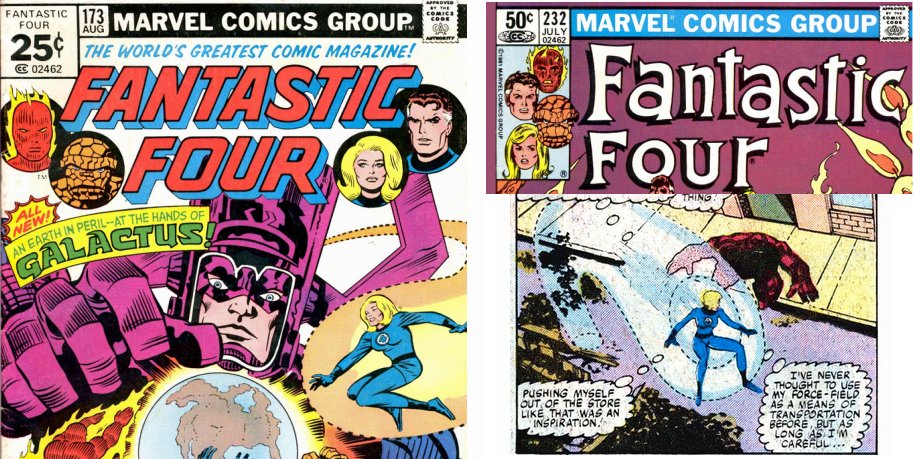
174
Issue 174: Different kinds of nation
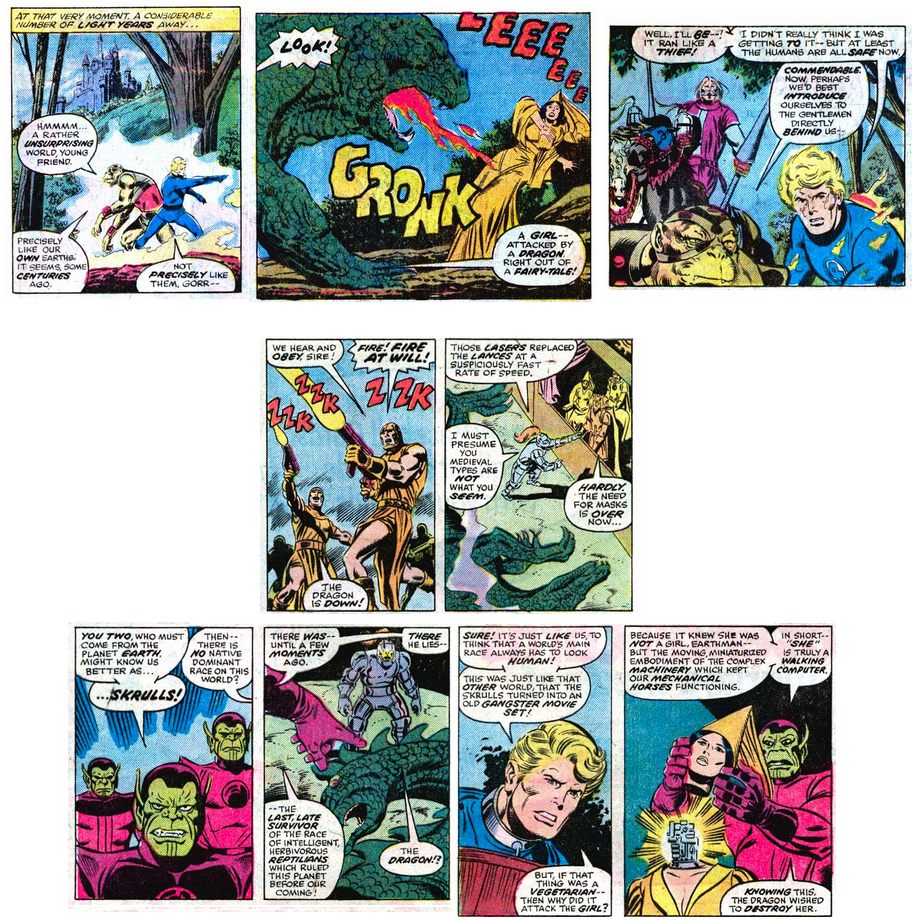
Here we continue the theme that appearances can be even more deceiving.
Incidentally, I love issues like this. The idea that the dragon was
innocent, and we should not judge by whether someone looks human.
Wrapping it all up in a fairy tale setting is the icing on the
delicious cake. The idea of a mechanical planet is pretty cool too,
and the idea that a friendly planet or nation can disagree with you
is realistic. These concepts are not just mind expanding, but apply
very well to a nation such as America and how it interacts with
other nations. These worlds can represent other nations: their
cultures and relationship with us varies wildly. We should never
jump to conclusions with other cultures: none of these three worlds
behaved as expected.
Also in this issue the men are all captured, so it's up to Sue to
save them single handedly, and she does. And in this issue Reed
finally admits to the others that he is losing his ability to
stretch.
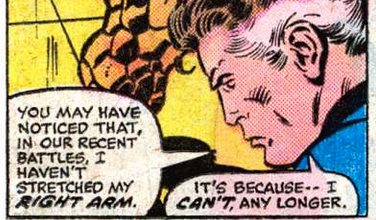
175
Issue 175: like Androcles and the lion
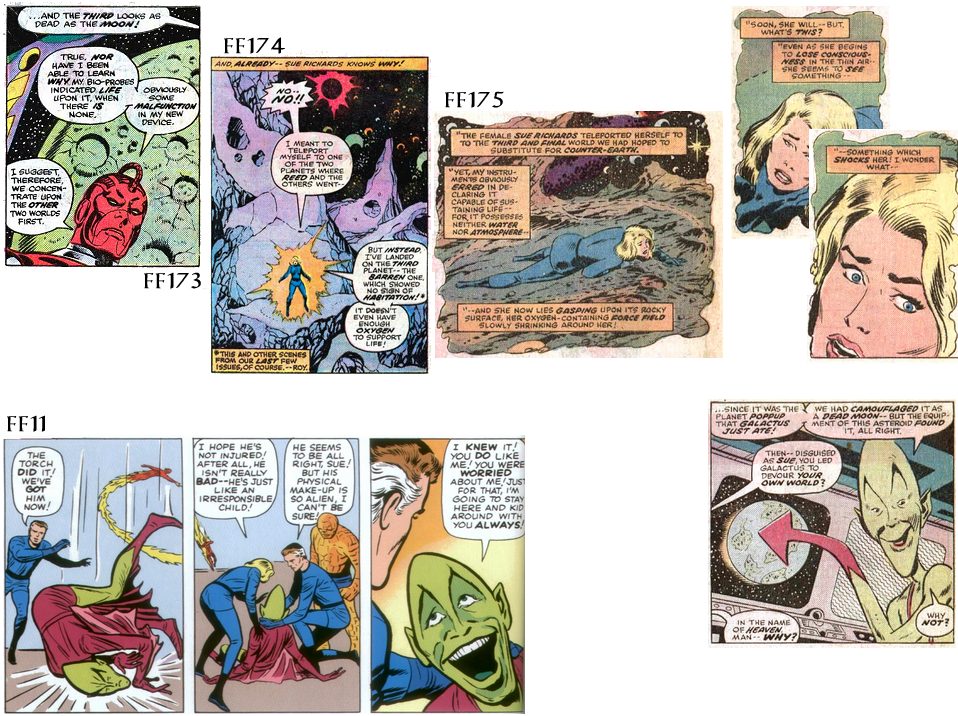
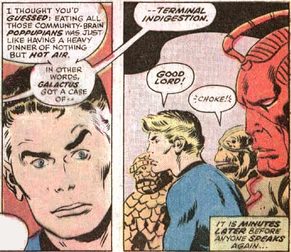
Reed is completely clueless: his told Sue to stay behind while
the men do the fighting. And all their fighting is useless.
Meanwhile, Sue accidentally finds the Impossible Man, who defeats
Galactus. it may not even be an accident - Sue, like the reader,
may have wondered about the mystery third planet, and her famous
intuition may have guided her hands when she went there. But even
if it was an accident, why did Impy decide to help her? He had no
interest in helping anybody before. But go back to issue 11: while
the boys (as usual) wanted to use violence, Sue had compassion,
and he noticed. It was the same with Gorr, and Dragon Man, and
Namor, and Triton: Sue's method is compassion and it makes her a
thousand times more useful than the boys.
Sue showed compassion to Impy, and Impy would have remembered.
She when she asked him to help, he said "why not?" It's like the
famous story of the lion with the thorn in his paw. In the legend
Androcles showed the lion kindness by removing the thorn. Years
later, the lion later remembers and saves Androcles' life. Would
Impy have helped Sue if she had not shown him compassion?
Everything we know about him comes from issue 11, and says no. Sue
did this, and it wasn't even acknowledged.
Sue's gentle approach saved the whole universe from Galactus. She
saved countless billion (probably trillion) lives. Nothing Reed
ever does will be as significant as what Sue just did (in fact, he
will later save Galactus and be put on trial for it). In the
battle of the sexes. Sue has won. And nobody even notices: she's
invisible as usual.
Ben's
changing relates to confidence.
Why did Ben change? The obvious answer is because Galactus zapped
him. Then why was the effect delayed? Galactus would know that
Ben's ability to change depends on his unconscious confidence. All
Galactus had to do was make Ben a little more aware of his fears,
then Ben would change back when he approached Earth and Alicia.
Why is Ben stronger than before? It appears that every major
change increases his strength (e.g. in FF214 after the Skrull
aging ray, and his power increase from the five ton level in the
early days, which coincided with several changes). If each change
is triggered by an unconscious need to be stronger it makes sense
that he would unconsciously allow himself a little extra strength
each time. Note that after spending time with the Hulk, Ben feels
the need to be physically larger as well. Strength of course
refers to his minimum strength, not his
maximum strength, which (as with the Hulk) is vastly higher.
The zeitgeist: God versus
evolution
Before I get any emails, yes I know that plenty of religious folk
see no problem with evolution. I count myself among them, but that
is a whole other topic. However, according to the spirit of the
age, God and evolution are opposites. The battle has been raging
ever since the rise of Christian fundamentalism in the 1920s, but
in the mid 1970s it was chosen as a political wedge issue, along
with abortion, to mobilize the Bible belt to vote Republican. It
led to Republicans dominating American politics for 30 years (and
Clinton, the sole Democrat president in that period, had to be
further to the right than many previous Republicans). This a major
theme in American history, and the Fantastic Four represents it
right at the start.
This illustrates the power of comics in showing the the
zeitgeist, and therefore why only a comic can be The Great
American Novel. Other novels can bore their readers with tedious
debates over theology, but only a comic can show God versus
Evolution battling each other on the cover! Galactus is of course
the Marvel metaphor for the God of the Old Testament (the greatest
of all, his word is truth, he judges the Earth, he is prepared to
wipe out the world), with the Silver Surfer as the metaphor for
Christ (he sacrifices himself for mankind and preaches). Galactus
is not actually God
(see the Watcher's quote in FF72), but serves as a metaphor (see
for example Anatomy
of a Classic: 'Fantastic Four' #50).
God versus evolution: who wins?
The battle is a masterstroke. Who will win? Does God defeat
evolution? Does evolution defeat God? Both positions carry risks,
but the comic answers it perfectly.
It may appear that evolution wins: the facts and the smart minds
and the rebels are on his side. But in the wider history Galactus
always comes back. Galactus is the unquestioned power while the
High Evolutionary is merely a footnote (and the loneliest of all:
see the comment near the end of FF annual 23). Also, Galactus is
only defeated by a vacuous world: a people who welcome him, but
they have no variety, no depth. The symbolism is obvious: God will
only die when his supporters become mindless shallow fanatics. But
in FF262 we see that the
deeper, most powerful, most thoughtful people see that Galactus is
essential to the universe.
Realism and the Impossible Man
A lot of readers hate The Impossible Man: "How do you ruin a Galactus story?
The easiest way is to have the Impossible Man figure into the
plot." (source)
Why do they hate him? They don't say, but I presume that people
find him hard to take seriously. Yet he's among the most realistic
of all the aliens in comics, for these reasons
Instant evolution:
Practically all aliens in comics have technology that's more
advanced than humans, yet it looks similar to our own: e.g. just
bigger space ships. This is not realistic. Given the age of the
universe any more advanced race will be at the very least a
few thousand years ahead of us. As is likely to be millions of
years more advanced. Imagine how much our technology could advance
in just the next few thousand years.
- Step 1: all-purpose tools. Not just computers but machines of
all kinds.
- Step 2: adapt our biology. Why carry it when it can be part of
us?
- Step 3: make it faster, easier... eventually we just adapt,
like instant evolution
A sense of humor:
Most aliens in comics are very serious. But why would they be?
They've solved all their problems, so they'll just want to have
fun! And they won't be smart because there will be no evolutionary
pressure to be smart. All we know is that if they come to Earth
then they must be interested in Earth. And their humor is likely
to be very anarchic: why have rules of decorum if you can do
anything?
Planetary indigestion
Why does Galactus want living worlds? Well, what does life have
that non-life does not? Complexity. Just compare organic molecules
to non-organic ones: what strikes you is their vastly more complex
structure. The same goes with intelligence: a bigger brain is more
complex. but it isn't just random complexity: you get that just
from chaos. What life has is order: in other words it has
information. Galactus feeds on the information in life. This is
why he's a test: if you can't avoid getting eaten then your
information was a lot less valuable than you thought.
How is the planet Poppup different? It's completely networked, to
such an infinite degree that the same information is everywhere,
If you pick one molecule and compare it to another then you get no
more information: it was all there in the first one. To do this it
must be fabulously efficient. A Poppup molecule might be a billion
time more complex than a human molecule, but if every molecule is
more or less the same then the total amount of information is
vastly less.
Incidentally, a Poppuppian can be seen as a super advanced
skrull: a shape changer to the 'n'th degree. Reed mentioned in FF
annual 17 that each skrull atom is like our own DNA. That then
goes for each Poppuppian atom, but even more so: every atom is the
same model, a general purpose changing machine that self organizes
with atoms around it
So imagine Galactus getting ready to eat a planet. I don't know
how he eats information, but it's a form of data processing. If we
compare it to every other kind of computer we can infer that he
has programs that expect different kinds of information, in vast
quantities. but the actual information he gets is vastly less. The
programs will spew out garbage, or even crash. If the output of
these programs is his life then he will die.
Creation myths and indigestion
The idea of a god eating the wrong thing and getting indigestion sounds
like something straight from a genuine creation myth. For example, the
Greek Titan Kronos swallowed all of his sons to prevent them taking his
power, but his wife Rheia tricked him into swallowing a stone in
stead of Zeus. Hence Zeus survived and became father to the gods.
Other points to note
- Contrast FF 175 (a quarter century anniversary) with FF 200. In both, members of the team regain their powers while in a space ship. But Ben knows that super powers
separate him from his fellow man, and does not want the powers. In
contrast, Reed feels useless without power: Reed is elitist, Ben is not.
Ben is right: as this issue confirms, real power lies in friendship (e.g. with the Impossible Man) not in focusing on one's personal strength.
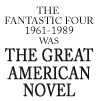


















 FF150
151
152
153
154
155
156
157
158
159
160
161
162
163
164
165
166
167
168
169
170
annual 11
171
172
173
174
175
FF150
151
152
153
154
155
156
157
158
159
160
161
162
163
164
165
166
167
168
169
170
annual 11
171
172
173
174
175














































































